中级宏观经济学作业四
中级宏观经济学试题-chapter 4

4.a. Chapter 4 suggests that the key to long-term economic growth is investment in human and physical capital with particular emphasis on research and development.
effects of capital investment. In other words, more investment not only leads to a higher and more
efficient capital stock but also to new ideas and new ways of doing things which can easily be copied
Solutions to the Problems in the Textbook
Conceptual Problems
1. Endogenous or self-sustained growth supposedly can be achieved by policies designed to affect the proportion of GDP that goes towards investment. The neoclassical growth model of Chapter 3 predicted that the long-term growth rate is determined only by population growth and technological progress and that changes in the savings rate have only transitory effects. The endogenous growth model, however, predicts that countries with a higher savings rate can achieve higher long-term growth and that a nation's government can affect the long-term growth rate by implementing policies that affect the savings rate.
中级宏观经济学习题
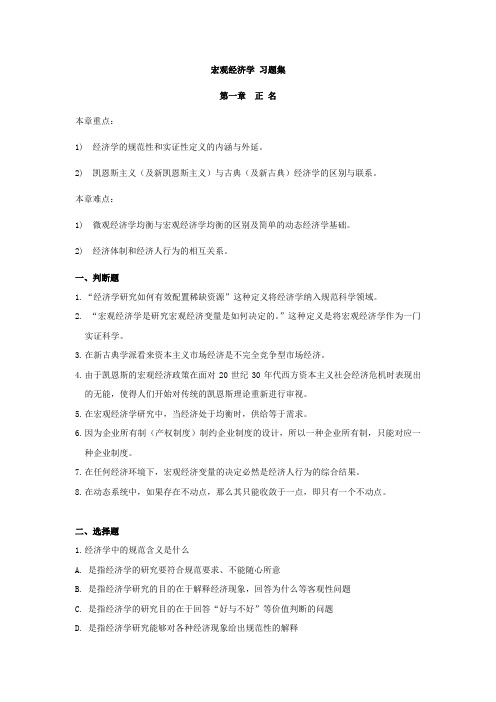
宏观经济学习题集第一章正名本章重点:1)经济学的规范性和实证性定义的内涵与外延。
2)凯恩斯主义(及新凯恩斯主义)与古典(及新古典)经济学的区别与联系。
本章难点:1)微观经济学均衡与宏观经济学均衡的区别及简单的动态经济学基础。
2)经济体制和经济人行为的相互关系。
一、判断题1.“经济学研究如何有效配置稀缺资源”这种定义将经济学纳入规范科学领域。
2.“宏观经济学是研究宏观经济变量是如何决定的。
”这种定义是将宏观经济学作为一门实证科学。
3.在新古典学派看来资本主义市场经济是不完全竞争型市场经济。
4.由于凯恩斯的宏观经济政策在面对20世纪30年代西方资本主义社会经济危机时表现出的无能,使得人们开始对传统的凯恩斯理论重新进行审视。
5.在宏观经济学研究中,当经济处于均衡时,供给等于需求。
6.因为企业所有制(产权制度)制约企业制度的设计,所以一种企业所有制,只能对应一种企业制度。
7.在任何经济环境下,宏观经济变量的决定必然是经济人行为的综合结果。
8.在动态系统中,如果存在不动点,那么其只能收敛于一点,即只有一个不动点。
二、选择题1.经济学中的规范含义是什么A. 是指经济学的研究要符合规范要求、不能随心所意B. 是指经济学研究的目的在于解释经济现象,回答为什么等客观性问题C. 是指经济学的研究目的在于回答“好与不好”等价值判断的问题D. 是指经济学研究能够对各种经济现象给出规范性的解释2.经济学中的实证含义是什么?A. 实证顾名思义就是指经济学的理论要能够指导实践B. 实际上实证的前提是要符合规范的要求C. 经济学研究的目的在于能够回答“应不应该”或“好还是坏”等问题,并能得到来自实践的支持,就是实证D. 通俗地讲,就是回答经济现象是什么?为什么?3.经济学的规范和实证的关系正确理解是A. 规范和实证是彼此对立的,因而经济学要么是规范的,要么就是实证的B. 因为经济学是社会学科,因而本质上经济学始终是规范的C. 规范以实证为基础,实证以规范为目的,因为经济学的目的是造福于人类D. 两者就是一回事,不过是一枚硬币的两面4.以下那个判断属于实证经济学?A. 通货膨胀率下降了B. 失业率太高了C. 经理人的工资不应该太高D. 降低失业率比抑制通货膨胀率更重要5.下列哪种表述属于实证表述A. 政府应该降低税收刺激经济以防经济恶化B. 减少货币供给将降低通货膨胀率C. 央行应该降低货币供给D. 社会应该要求福利领取者去找工作6.以下各项中不属于宏观经济学中探讨的经济变量是:A、就业率B、国民生产总值C、通货膨胀率D、企业产量7.下列题目那些是宏观经济学研究的内容A. 家庭把多少收入用于娱乐消费的决策B. 政府管制对汽车废气的影响C. 高国民储蓄对经济增长的影响D. 企业关于雇佣多少工人的决策8.下列对市场经济的描述中不属于凯恩斯学派观点的是:A、信息传递不对称B、未来不能合理预期C、完全竞争市场D、价格调整具有粘性9.在新古典经济学看来,资本主义市场经济是:A. 不完全竞争的B. 信息是不完全的,具有非对称性C. 预期具有不确定性D. 具有充分弹性,能够有效地进行自我调整,因而政府的干预是不必要的10.经济学中的理性人是指什么?A. 是指经济主体都是自私自利之徒B. 是指经济主体在做经济决策时,都充满理性、计算得失以求自身利益最大化C. 一个利他主义者,绝对不会是一个理性人D. 理性人是经济学中最不现实的假设,它将经济学研究带入了歧途,老早就应该抛弃11.一个国家的经济体制可以靠什么来区分A. 社会的福利水平B. 是不是拥有私人财产C. 社会经济资源的分配和调节机制,基本的企业制度D. 看什么样的政党在执政9.有什么样的经济运行机制,就会有什么样的企业制度你认为正确否A. 客观讲,经济运行机制和企业制度之间并不是一个严格的一一对应关系,同时它们之间又确实存在着相互适应的问题B. 不正确,因为经济运行机制与企业制度之间并不存在彼此决定的关系C. 应该是企业制度决定经济运行机制D. 这个问题太复杂,根本就说不清10.尽管经济体制制约着经济人(个人、企业、政府等)的行为,经济人仍有某些共性比如:A. 企业按照市场价格决定产量B. 政府追求低失业率低通货膨胀C. 追求自身利益最大化D. 企业追求市场份额和稳定增长11.下面关于经济体制的描述中哪个是错误的:A. 经济体制是影响经济环境最重要的因素之一B. 经济体制包括经济运行机制和企业制度C. 经济体制是经济资源的调节和分配机制D. 构成经济体制的两大基本要素必须相互适应12.下列描述中哪个是错误的:A. 新古典学派和凯恩斯学派在经济学研究的某一阶段被当时在学术界占统治地位的经济学家们结合起来,组成新古典综合派中微观经济学和宏观经济学两大体系。
chap4中级宏观经济学答案 华中科技大学

Microeconomics, 4e (Perloff)Chapter 4 Consumer Choice4.1 Preferences1) An indifference curve represents bundles of goods that a consumerA) views as equally desirable.B) ranks from most preferred to least preferred.C) refers to any other bundle of goods.D) All of the above.Answer: ATopic: Preferences2) The assumption of completeness means thatA) the consumer can rank all possible consumption bundles.B) more of a good is always better.C) the consumers can rank all affordable consumption bundles.D) all preferences conditions are met.Answer: ATopic: Preferences3) If a consumer prefers Apples to Bananas and prefers Bananas to Citrus Fruit, in order to satisfy assumptions about preferences she has to preferA) Bananas to Apples.B) Citrus Fruit to Bananas.C) Apples to Citrus Fruit.D) Citrus Fruit to Apples.Answer: CTopic: Preferences4) The principle that "More is better" results in indifference curvesA) sloping down.B) not intersecting.C) reflecting greater preferences the further they are from the origin.D) All of the above.Answer: DTopic: Preferences5) There is an indifference curve through every bundle because of the assumption ofA) transitivity.B) completeness.C) rationality.D) nonsatiation.Answer: BTopic: Preferences6) Indifference curves are downward sloping because of the assumption ofA) completeness.B) transitivity.C) more is better.D) All of the above.Answer: CTopic: Preferences7) If two indifference curves were to intersect at a point, this would violate the assumption ofA) transitivity.B) completeness.C) Both A and B above.D) None of the above.Answer: ATopic: Preferences8) Indifference curves that are thick violateA) the assumption of transitivity.B) the assumption that more is better.C) the assumption of completeness.D) none of the assumptions.Answer: BTopic: Preferences9) A consumer's willingness to trade one good for another can be expressed by the consumer'sA) indifference curve.B) marginal rate of substitution.C) Both A and B above.D) None of the above.Answer: CTopic: Preferences10) Convexity of indifference curves implies that consumers are willing toA) give up more "y" to get an extra "x" the more "x" they have.B) give up more "y" to get an extra "x" the less "x" they have.C) settle for less of both "x" and "y".D) acquire more "x" only if they do not have to give up any "y".Answer: BTopic: Preferences11) Measuring "y" on the vertical axis and "x" on the horizontal axis, convexity of indifference curves implies that the MRS of "y" for "x"A) is decreasing as "x" increases.B) is increasing as "x" increases.C) is constant as "x" increases.D) cannot be calculated for large levels of "x".Answer: ATopic: Preferences12) Diminishing marginal rate of substitution can be seen when indifference curvesA) cross.B) are convex.C) are downward sloping.D) become flatter as we move down and to the right.Answer: DTopic: Preferences13) For which of the following pairs of goods would most people likely have convex indifference curves?A) nickels and dimesB) left shoes and right shoesC) movie tickets and concert ticketsD) None of the above.Answer: CTopic: Preferences14) If two goods are perfect substitutes, then the indifference curves for those two goods would beA) upward sloping and concave to the origin.B) downward sloping and convex to the origin.C) downward sloping and straight.D) L-shaped.Answer: CTopic: Preferences15) The indifference curves for left shoes and right shoes would most likely beA) upward sloping and concave to the origin.B) downward sloping and convex to the origin.C) downward sloping and straight lines.D) L-shaped.Answer: DTopic: PreferencesFor the following, please answer "True" or "False" and explain why.16) Indifference curves cannot intersect.Answer:True. As seen in the above figure, points a and c are on the same indifference curve and are therefore equally preferred. Points b and c are also on the same indifference curve and are therefore equally preferred. Transitivity implies that the consumer would be indifferent between a and b; however, since more is preferred to less, a is preferred to b. Thus, as a result of the assumption of transitivity and the assumption that more is preferred to less, indifference curves cannot intersect.Topic: Preferences17) Indifference curves cannot ever be concave for two goods.Answer: False. While indifference curves are typically convex, they can be concave. This means, however, that the MRS of y for x increases as x increases. That is, the consumer places greater value on the next x the more x she has. The interpretation is that a consumer with concave indifference curves prefers to specialize in either x or y but not have a mix of both.Topic: Preferences18) Indifference curves for perfect substitutes must be parallel lines with a slope of negative one. Answer: False. Indifference curves for perfect substitutes are parallel lines, but the slope is not necessarily negative one.Topic: Preferences19) Indifference curves on the same indifference map can have different shapes.Answer: True. Indifference curves can meet all the necessary requirements and still have different shapes. Topic: Preferences20) Lisa views pizzas and burritos as goods. If she prefers a bundle of 4 burritos and 4 pizzas to a bundle of 4 burritos and 5 pizzas, which property of consumer preference is violated? What change in the assumptions could lead a rational consumer to prefer the first bundle?Answer: The property of more-is-better is violated. However, if pizza is a bad, then a rational consumer would prefer the first bundle.Topic: Preferences21) Explain why most indifference curves are convex.Answer: Diminishing marginal rates of substitution make most indifference curves convex. When people have a lot of one good, they are willing to give up a relatively larger amount of it to get a good of which they have relatively little.Topic: Preferences22) Draw the indifference curves for rock concerts and food for each of the following:(a) a typical 17-year-old(b) a typical 75-year-oldAnswer:See the above figure. These graphs assume that a typical 17-year-old would enjoy both food and rock concerts. The 75-year-old might find the rock concerts neutral or even bad.Topic: Preferences23) Draw the indifference curves for nickels and dimes. Would they ever have a non-constant slope? Explain.Answer:See the above figure. Two nickels are worth 1 dime. Yet, for extremely large amounts of money, people might prefer dimes to nickels for carrying purposes. That is why people often pay with exact change or don't like to break a twenty.Topic: Preferences4.3 Budget Constraint1) Joe's income is $500, the price of food (F) is $2 per unit, and the price of shelter (S) is $100. Which of the following represents his budget constraint?A) 500 = 2F + 100SB) F = 250 - 50SC) S = 5 - .02FD) All of the above.Answer: DTopic: Budget Constraint2) Joe's income is $500, the price of food (F) is $2 per unit, and the price of shelter (S) is $100. Which of the following represents his marginal rate of transformation of food for shelter?A) -5B) -50C) -.02D) None of the above.Answer: BTopic: Budget Constraint3) Joe's income is $500, the price of food (F) is $2 per unit, and the price of shelter (S) is $100. Which of the following represents his budget constraint?A) 500 = 100F + 2SB) 500 = 2F + 100SC) S = 500 - 2FD) All of the above.Answer: BTopic: Budget Constraint4) Joe's budget constraint equals 500 = 2F + 100S, where $500 is Joe's income, $2 is the price of food (F) and $100 is the price of shelter (S). How much food can Joe buy if he buys one unit of shelter?A) 2 unitsB) 200 unitsC) 250 unitsD) 400 unitsAnswer: BTopic: Budget Constraint5) Joe's income is $500, the price of food (F) is $2, and the price of shelter (S) is $100. Which of the following bundles is in Joe's opportunity set?A) 50 units of food, 5 units of shelterB) 200 units of food, 2 units of shelterC) 100 units of food, 1 unit of shelterD) 150 units of food, 3 units of shelterAnswer: CTopic: Budget Constraint6) The marginal rate of transformation of y for x representsA) the slope of the budget constraint.B) the rate at which the consumer must give up y to get one more x.C) - ⌧/⍓.D) All of the above.Answer: D Topic: Budget Constraint7) The marginal rate of transformation of y for x representsA) the slope of the budget constraint.B) the rate at which the consumer must give up x to get one more y.C) -P y/ P x.D) All of the above.Answer: ATopic: Budget Constraint8) The rate at which a consumer must give up y to get one more x is equal toA) – P x / P y.B) - P y / P x.C) – MU x / MU y.D) MU y / MU x.Answer: ATopic: Budget Constraint9) Betty consumes good x and good y. If the price of x = $3 and the price of y = $4, thenA) an extra unit of x costs 4/3 units of y.B) an extra unit of y costs 4/3 units of x.C) an extra unit of x costs 3/4 units of y.D) Both B and C.Answer: DTopic: Budget Constraint10) If the price of one good increases while the price of the other good and the consumer's income remain unchanged, what will happen to the budget line?A) The budget line rotates inward from the intercept on the axis of the good that did not change in price.B) The budget line rotates outward from the intercept on the axis of the good that did not change in price.C) The budget line shifts inward without a change in slope.D) The budget line shifts outward without a change in slope.Answer: ATopic: Budget Constraint11) Lisa eats both pizzas and burritos. If the price of a pizza increases, Lisa's opportunity setA) becomes larger.B) becomes smaller.C) is unchanged.D) cannot be determined without more information.Answer: BTopic: Budget Constraint12) If the consumer's income increases while the prices of both goods remain unchanged, what will happen to the budget line?A) The budget line rotates inward from the intercept on the horizontal axis.B) The budget line rotates outward from the intercept on the vertical axis.C) The budget line shifts inward without a change in slope.D) The budget line shifts outward without a change in slope.Answer: DTopic: Budget Constraint13) If the prices of both goods and income increase by the same percentage, what will happen to the budget line?A) The budget line rotates inward from the intercept on the axis of the good that did not change in price.B) The budget line rotates outward from the intercept on the axis of the good that did not change in price.C) The budget line shifts outward without a change in slope.D) Nothing.Answer: DTopic: Budget Constraint14) A consumer buys food (F) and shelter (S). If the consumer's income rises and there is no change in the prices of F or S, the marginal rate of transformation of F for S willA) increase.B) decrease.C) stay the same.D) change, but there is not enough information to know how.Answer: CTopic: Budget Constraint15) If both prices increases by 50%A) budget constraint will be unchanged.B) slope of the budget constraint stay the same.C) slope of the budget constraint will decrease.D) budget constraint will shift outward in a parallel fashion.Answer: BTopic: Budget Constraint16) If both prices decreases by 50%A) budget constraint will be unchanged.B) slope of the budget constraint will increase.C) slope of the budget constraint will decrease.D) budget constraint will shift outward in a parallel fashion.Answer: DTopic: Budget Constraint17) If a consumer's budget line for food (F) and shelter (S) is represented as F = 250 - 5S, we know thatA) the consumer's income is 250.B) the price of shelter is 5.C) the price of shelter is 5 times the price of food.D) All of the above.Answer: CTopic: Budget ConstraintFor the following, please answer "True" or "False" and explain why.18) The slope of the budget line represents the rate at which the consumer is willing to trade one good for another at any given bundle.Answer: False. This describes the slope of the indifference curve. The slope of the budget line represents the rate at which the consumer must trade one good for another at any given bundle.Topic: Budget Constraint19) Joe subscribes to an Internet provider that charges $2 per hour. Draw his budget line for Internet access on the horizontal axis and money spent on all other goods on the vertical axis assuming he has $100 per month to spend. Another company offers unlimited Internet access for a flat monthly fee of $20. Draw this budget line.Answer:See the above figure.Topic: Budget Constraint20) Lisa has an income of $100. She spends all of her income on pizza and burritos. A pizza costs $10 and a burrito costs $5. However, the store where Lisa buys her burritos has a special deal. After you've bought 6 burritos, then you can buy each burrito for $2.50. Draw Lisa's opportunity set.Answer:See the above figure.Topic: Budget Constraint21) Explain the difference between the marginal rate of substitution and the marginal rate of transformation. Answer: The marginal rate of substitution is a consumer's willingness to trade one good for another based on utility. The marginal rate of transformation is the consumer's ability to trade one good for another based on prices.Topic: Budget Constraint4.4 Constrained Consumer Choice1) Economists assume consumers select a bundle of goods that maximizes their well-being subject toA) their budget constraint.B) their income.C) relative prices.D) their marginal rate of substitution.Answer: ATopic: Constrained Consumer Choice2) An optimum that occurs as a corner solutionA) includes only one good.B) cannot be an equilibrium.C) cannot exhaust the budget constraint.D) includes the exact same amounts of each good.Answer: ATopic: Constrained Consumer Choice3) The consumer is in equilibrium whenA) MRT = MRS.B) P x / P y = MUx y / MU y.C) the budget line is tangent to the indifference curve at the bundle chosen.D) All of the above.Answer: DTopic: Constrained Consumer Choice4) By selecting a bundle where MRS = MRT, the consumer isA) achieving a corner solution.B) reaching the highest possible indifference curve she can afford.C) not behaving in an optimal way.D) All of the above.Answer: BTopic: Constrained Consumer Choice5) By selecting a bundle where MRS = MRT, the consumer is sayingA) "I value my last unit of each good equally."B) "I am willing to trade one good for the other at the same rate that I am required to do so."C) "I will equate the amounts spent on all goods consumed."D) All of the above.Answer: BTopic: Constrained Consumer Choice6) Assume the price of beer is $4, the price of pizza is $10 and the consumer's income is $250. Which consumption bundle will NOT be the consumers choice?A) A(5 Beer, 5 Pizza)B) B(0 Beer, 25 Pizza)C) C(25 Beer, 15 Pizza)D) None of the bundle will be chosen.Answer: ATopic: Constrained Consumer Choice7) With respect to consuming food and shelter, two consumers face the same prices and both claim to be in equilibrium. We therefore know thatA) they both have the same marginal utility for food.B) they both have the same marginal utility for shelter.C) they both have the same MRS of food for shelter.D) All of the above.Answer: CTopic: Constrained Consumer Choice8) Johnny has allocated $30 toward coffee and tea and feels that coffee and tea are perfect substitutes. Due to differences in caffeine levels, his MRS of tea for coffee equals 2. If coffee and tea sell for the same price, Johnny willA) spend all $30 on tea.B) spend all $30 on coffee.C) spend $20 on coffee and $10 on tea.D) be indifferent between any bundle of coffee and tea costing $30.Answer: BTopic: Constrained Consumer Choice9) Max has allocated $100 toward meats for his barbecue. His budget line and an indifference map are shown in the above figure. Which bundle will Max choose?A) aB) bC) cD) dAnswer: BTopic: Constrained Consumer Choiceshown in the above figure. What is the price of chicken?A) $0.80/lbB) $1.25/lbC) $4/lbD) $5/lbAnswer: DTopic: Constrained Consumer Choice11) Max has allocated $100 toward meats for his barbecue. His budget line and an indifference map are shown in the above figure. If the price of burger increases,A) Max will buy less burger and more chicken.B) Max will buy less burger and the same quantity of chicken.C) Max will buy less of both meats.D) More information is needed to answer the question.Answer: DTopic: Constrained Consumer Choice12) Max has allocated $100 toward meats for his barbecue. His budget line and an indifference map are shown in the above figure. What happens if Max's mother gives him 10 pounds of burger?A) Max would have preferred receiving the dollar value of the burger.B) Max is indifferent between this gift and the dollar value of the burger.C) Max prefers this gift to the dollar value of the burger.D) None of the above.Answer: BTopic: Constrained Consumer Choice13) Max has allocated $100 toward meats for his barbecue. His budget line and an indifference map are shown in the above figure. What happens if Max's mother gives him 30 pounds of burger?A) Max would have preferred receiving the dollar value of the burger.B) Max is indifferent between this gift and the dollar value of the burger.C) Max prefers this gift to the dollar value of the burger.D) None of the above.Answer: ATopic: Constrained Consumer Choice14) Max has allocated $100 toward meats for his barbecue. His budget line and an indifference map are shown in the above figure. What happens if Max receives a $100 cash grant to buy either meat or chicken?A) Max will double his consumption of both meats.B) Max will spend it all on burger. Because of its lower price, he can buy more of it.C) Max will take advantage of the gift by buying all chicken because it is the more expensive meat.D) There is not enough information to answer the question.Answer: ATopic: Constrained Consumer Choice15) Max has allocated $100 toward meats for his barbecue. His budget line and an indifference map are shown in the above figure. Which of the following best describes Max's preferences?A) d > b > eB) d = b = eC) a = b > cD) a = b > eAnswer: DTopic: Constrained Consumer Choiceshown in the above figure. Which of the following bundles are in Max's opportunity set?A) a, b, cB) b, d, eC) a, b, dD) None of the above.Answer: BTopic: Constrained Consumer Choice17) Max has allocated $100 toward meats for his barbecue. His budget line and indifference map are shown in the above figure. If the price of burger increases, which of the following bundles are in Max's opportunity set?A) b, d, eB) d, eC) a, b, c, d, eD) None of the labeled points are in Max's opportunity set.Answer: DTopic: Constrained Consumer Choice18) Cash may be preferred to food stamps because additional cashA) rotates the budget constraint.B) shifts out the budget constraint at every point.C) provides a smaller opportunity set.D) allows the purchase of more food.Answer: BTopic: Constrained Consumer Choice19) Max has allocated $100 toward meats for his barbecue. His budget line and indifference map are shown in the above figure. If Max is currently at point eA) his MRS is less than the trade-off offered by the market.B) is willing to give up more burger than he has to given market prices.C) is not maximizing his utility.D) All of the above.Answer: DTopic: Constrained Consumer Choice20) Max has allocated $100 toward meats for his barbecue. His budget line and indifference map are shown in the above figure. If Max is currently at point dA) his MRS is larger than the trade-off offered by the market.B) is willing to give up more chicken than he has to given market prices.C) is not maximizing his utility.D) All of the above.Answer: DTopic: Constrained Consumer ChoiceFor the following, please answer "True" or "False" and explain why.21) Consumers do not prefer gifts-in-kind to cash gifts.Answer: True. It is possible the consumer would buy the same gift with cash and therefore be just as well off. If the consumer bought something other than the gift, that means that this something else is preferred to the gift. At best, the gift yields the same utility as would have been achieved with the cash, but never more. Topic: Consumer's Constrained Choice22) If MRS > MRT, then the consumer is better off than at equilibrium.Answer: False. MRS > MRT implies that the consumer values the next unit of "x" more than it costs to obtain it. That is, there is a gain from trade to be made. As more "x" is purchased, MRS falls and eventually MRS = MRT. At this point, all gains from trade have been made.Topic: Constrained Consumer Choice23) Joe subscribes to an Internet provider that charges $2 per hour. He has $100 per month to spend and is at equilibrium by buying 10 hours of Internet access and $80 worth of other goods. Draw the indifference curve and budget line. If the company switches to a $20 monthly fee for unlimited Internet access, is Joe better off? Answer:See the above figure. Under the new plan Joe can still purchase his original bundle and get additional time on the Internet for free. Note that had Joe been consuming less than 10 hours at $2 per hour, the new pricing policy would leave him worse off.Topic: Constrained Consumer Choice24) Suppose Joe's utility for lobster (L) and soda (S) can be represented as U = L0.5 S0.5. Joe walks into a restaurant with $72. Lobsters cost $18 each and sodas cost $2 each. How much lobster and soda will Joe consume if he intends to spend all his money? (There are no tax and no tips.)Answer: Maximizing Joe's utility subject to his budget constraint yields:U = L0.5 S0.5 + l(72 - 18L - 2S)1. dU/dL = 0.5 L-0.5 S0.5. - l18 = 02. dU/dL = 0.5 L0.5 S-0.5 - l2 = 03. dU/dL = 72 - 18L - 2S = 0From 1) and 2), S/L = 9 or S = 9L. Substituting into 3) yields 72 - 36L = 0 or L = 2. Since S = 9L, S = 18. Thus, Joe will buy 2 lobsters and wash it all down with 18 sodas.Topic: Constrained Consumer Choice25) Joe's indifference map for lobster and soda is shown in the above figure along with his budget line. Will Joe choose point a? Explain your answer in terms both of MRS and the level of utility.Answer: Joe will not choose point a. Since the slope of his budget line tells us that he must give up only 9 sodas to get a lobster, Joe will wish to buy more lobsters and less soda than bundle a provides. From a utility standpoint, Joe will not choose point a because another bundle that lies on a higher indifference curve is obtainable.Topic: Constrained Consumer Choice26) John is indifferent between canned soup and fresh soup. Canned soup sells for $1 per serving and fresh soup sells for $2 per serving. Assuming that John has allocated $4 toward soup, how will he spend it? Explain your answer by drawing John's budget line and indifference curves.Answer:See the above figure. Canned and fresh soups are perfect substitutes. A corner solution exists where John spends all $4 on canned soup.Topic: Constrained Consumer Choice27) Suppose that left shoes and right shoes must be purchased separately. Ingrid needs an equal number of each type of shoe and has a budget of $100 for shoes. Left shoes always cost $1. If right shoes cost $19 each, how many of each will Ingrid buy? If the price of right shoes increases to $49 each, how will Ingrid react? Explain your answer by drawing the indifference curves and budget lines.Answer:See the above figure. Since Ingrid needs an equal number of each type of shoe, left shoes and right shoes are perfect complements. If right shoes are $19 each, Ingrid purchases 5 pairs of shoes. If right shoes are $49 each, Ingrid purchases 2 pairs.Topic: Constrained Consumer Choice28) Johnny has $100 to spend on books and all other goods. Books cost $20 each and Johnny is at equilibrium consuming 3 books and $40 worth of other goods. Johnny's grandmom wants to give Johnny either a book or $20 for his birthday. Which gift does Johnny prefer? Explain using an indifference map and budget lines.Answer:See the above figure. Since Johnny's equilibrium book consumption exceeds the quantity of books in the gift-in-kind, Johnny is indifferent between receiving the book or the cash. Had Johnny been consuming less than one book, he would have preferred the cash.Topic: Constrained Consumer Choice29) Lisa consumes only pizzas (P) and burritos (B). Her utility function is U = P0.5 B0.5. The price of per pizza is $10 and the price per burrito is $5. In equilibrium, Lisa consumes 4 pizzas. Using Lisa's utility function, calculate how many burritos she consumes.Answer: The marginal utility of pizza equals B0.5/2P0.5. The marginal utility of a burrito equals P0.5/2B0.5. In equilibrium, the ratio of the marginal utilities will equal the ratio of prices. The ratio of marginal utilities simplifies to B/P. The ratio of prices is 10/5. Since we know that Lisa consumes 4 pizzas, she must consume 8 burritos.Topic: Constrained Consumer Choice30) Lisa consumes only pizzas and burritos. In equilibrium, her marginal utility of pizza is 20 and her marginal utility of a burrito is 10. The price of a pizza is $4. What is the price of a burrito?Answer: In equilibrium, the ratio of the marginal utility of a pizza divided by the price of a pizza must equal the marginal utility of a burrito divided by the price of a burrito. Thus, the price of a burrito must be $2. Topic: Constrained Consumer Choice21。
张延《中级宏观经济学》课后习题详解(4第四章 产品市场和货币市场的同时均衡:IS-LM模型)
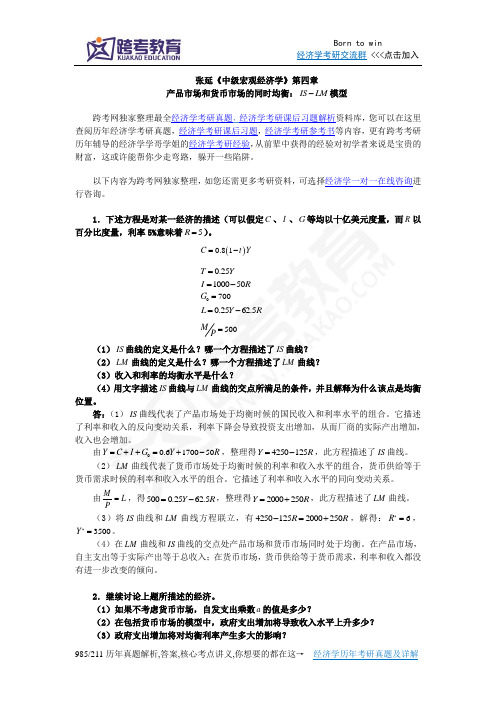
张延《中级宏观经济学》第四章产品市场和货币市场的同时均衡:IS LM -模型跨考网独家整理最全经济学考研真题,经济学考研课后习题解析资料库,您可以在这里查阅历年经济学考研真题,经济学考研课后习题,经济学考研参考书等内容,更有跨考考研历年辅导的经济学学哥学姐的经济学考研经验,从前辈中获得的经验对初学者来说是宝贵的财富,这或许能帮你少走弯路,躲开一些陷阱。
以下内容为跨考网独家整理,如您还需更多考研资料,可选择经济学一对一在线咨询进行咨询。
1.下述方程是对某一经济的描述(可以假定C 、I 、G 等均以十亿美元度量,而R 以百分比度量,利率5%意味着5R =)。
()0.81C t Y =-0.25T Y =100050I R =-0700G =0.2562.5L Y R =-500M P =(1)IS 曲线的定义是什么?哪一个方程描述了IS 曲线?(2)LM 曲线的定义是什么?哪一个方程描述了LM 曲线?(3)收入和利率的均衡水平是什么?(4)用文字描述IS 曲线与LM 曲线的交点所满足的条件,并且解释为什么该点是均衡位置。
答:(1)IS 曲线代表了产品市场处于均衡时候的国民收入和利率水平的组合。
它描述了利率和收入的反向变动关系,利率下降会导致投资支出增加,从而厂商的实际产出增加,收入也会增加。
由00.6170050Y C I G Y R =++=+-,整理得4250125Y R =-,此方程描述了IS 曲线。
(2)LM 曲线代表了货币市场处于均衡时候的利率和收入水平的组合,货币供给等于货币需求时候的利率和收入水平的组合。
它描述了利率和收入水平的同向变动关系。
由M L P=,得5000.2562.5Y R =-,整理得2000250Y R =+,此方程描述了LM 曲线。
(3)将IS 曲线和LM 曲线方程联立,有42501252000250R R -=+,解得:6R *=,3500Y *=。
(4)在LM 曲线和IS 曲线的交点处产品市场和货币市场同时处于均衡。
宏观经济学作业(必作)

宏观经济学习题(必作)第一章:1.如何理解宏观经济学的研究对象?2.简述宏观经济学的学科体系。
3.试说明宏观经济学是怎样运用总量分析方法的。
4.古典经济学家有哪些主要的宏观经济观点?5.新古典经济学形成了哪些重要的宏观经济思想?6.凯恩斯革命的主要内容是什么?7.凯恩斯主义宏观经济理论的逐步完善主要体现在哪些方面?8.宏观经济学进一步发展呈现出哪些重要趋势?第二章1.名词解释:流量存量 GDP GNP NDP PDI PI 国民收入支出法收入法GDP缩减指数真实GDP 名义GDP 价格指数失业自然失业率充分就业潜在GDP 奥肯定律2.国民收入核算指标的问题是什么?应如何纠正?3.分别绘出两部门、三部门和四部门经济循环图并加以说明。
4.物价和就业水平的衡量有哪些主要指标?应如何加以运用?5.已知某国有如下统计资料(单位:亿元)资本消耗补偿356.4,雇员酬金1 866.6,企业利息支付264.9,间接税266.3,个人租金收入34.1,公司利润164.8,非公司业主收入120.8,红利66.4,社会保险税253.9,个人所得税402.1,消费者支付的利息64.4,政府支付的利息105.1,政府和企业的转移支付374.5,个人消费支出1 991.9。
分别计算国民收入、国内生产净值、国内生产总值、个人收入、个人可支配收入和个人储蓄。
6.假定国内生产总值是5 000,个人可支配收入是4 100,政府预算赤字是200,消费是3 800,贸易赤字是100(单位:亿美元)。
试计算:(1)储蓄;(2)投资;(3)政府支出7.设一经济社会生产五种产品,它们在1990年和1992年的产量和价格分别如下表所示。
产品 1990年的产量 1990年的价格 1992年产量 1992年价格(美元) (美元)A 25 1.50 30 1.60B 50 7.50 60 8.00C 40 6.00 50 7.00D 30 5.00 35 5.50E 60 2.00 70 2.50试计算:(1)1990年和1992年的名义国内生产总值;(2)如果以1990年以基年,则1992年的实际国内生产总值;(3)计算1990~1992年的国内生产总值缩减指数。
中宏第4次作业参考答案

中级宏观经济学第四次作业*⼀、单项选择(12分)1、(4分)某国的实际GDP平均每年增长6.5%,资本存量为一年的GDP的3.5倍左右,资本折旧约为GDP的10%,资本收入约为GDP的30%。
由此判断该国的资本存量(A)A.高于黄金律水平B.等于黄金律水平C.低于黄金律水平D.无法判断【参考答案】K=3.5YδK=0.1YMP K×K=0.3Yn+g=6.5%解得δ=0.1/3.5≈0.029,MP K=0.3/3.5≈0.086,因此MP K−δ=5.7%<6.5%=n+g。
故经济拥有的资本多于黄金律稳态。
2、(4分)关于总需求曲线,下列说法正确的是(D)A.总需求曲线的移动一定是由货币供给量的变化造成的B.实际货币余额的需求增加一定导致总需求曲线向右移动C.总需求曲线反映了物价水平与收入之间的一种正相关关系D.对于固定的货币供给和货币流通速度,数量方程式反映出价格水平与产出量的负相关关系3、(4分)某经济开始时处于长期均衡,如果受到不利的供给冲击的同时货币流通速度外生地提高,可以预计,在短期内(C)A.产出将上升,价格可能上升、下降或者不变B.产出将下降,价格可能上升、下降或者不变C.价格将上升,产出可能上升、下降或者不变*请于2017年11⽉28⽇星期⼆课前提交纸质版作业。
1D.价格将下降,产出可能上升、下降或者不变【参考答案】二、(经济增长II,64分)请回答以下问题1、证明下列关于有人口增长和技术进步的索洛模型(Y=F(K,L×E))的稳态的每一条表述。
a.(4分)资本—产出比率是不变的。
【参考答案】In the steady state,we know that sy=(δ+n+g)k.This implies thatk/y=s/(δ+n+g).Since s,δ,n,and g are constant,this means that the ratio k/y is also constant.Since k/y= [K/(LE)]/[Y/(LE)]=K/Y,we can conclude that in the steady state,the capital–output ratio is constant.b.(4分)资本和劳动各自赚取了经济的一个不变份额的收入。
亚伯《中级宏观经济学》(第6版)笔记和课后习题详解 第4章 消费、储蓄与投资【圣才出品】
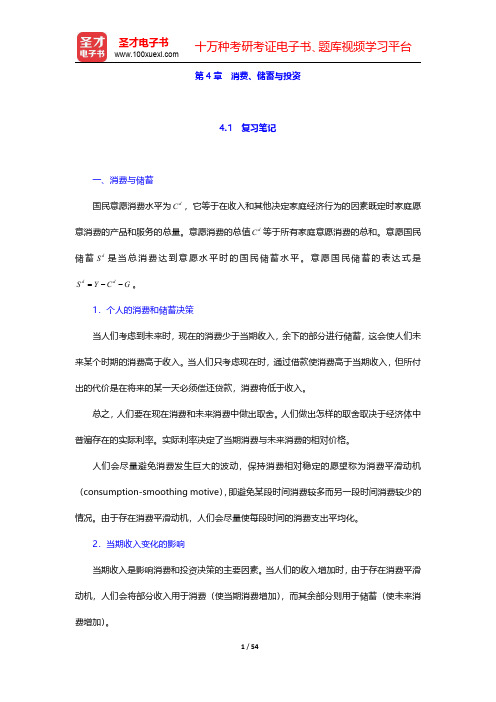
第4章消费、储蓄与投资4.1复习笔记一、消费与储蓄国民意愿消费水平为d C,它等于在收入和其他决定家庭经济行为的因素既定时家庭愿意消费的产品和服务的总量。
意愿消费的总值d C等于所有家庭意愿消费的总和。
意愿国民储蓄d S是当总消费达到意愿水平时的国民储蓄水平。
意愿国民储蓄的表达式是d d=--。
S Y C G1.个人的消费和储蓄决策当人们考虑到未来时,现在的消费少于当期收入,余下的部分进行储蓄,这会使人们未来某个时期的消费高于收入。
当人们只考虑现在时,通过借款使消费高于当期收入,但所付出的代价是在将来的某一天必须偿还贷款,消费将低于收入。
总之,人们要在现在消费和未来消费中做出取舍。
人们做出怎样的取舍取决于经济体中普遍存在的实际利率。
实际利率决定了当期消费与未来消费的相对价格。
人们会尽量避免消费发生巨大的波动,保持消费相对稳定的愿望称为消费平滑动机(consumption-smoothing motive),即避免某段时间消费较多而另一段时间消费较少的情况。
由于存在消费平滑动机,人们会尽量使每段时间的消费支出平均化。
2.当期收入变化的影响当期收入是影响消费和投资决策的主要因素。
当人们的收入增加时,由于存在消费平滑动机,人们会将部分收入用于消费(使当期消费增加),而其余部分则用于储蓄(使未来消费增加)。
边际消费倾向(marginal propensity to consume,MPC)是当期收入的增量中用于增加当期消费的比例。
由于人们不会消费掉全部的额外收入,因此,MPC界于0和1之间。
可以预见到总产出(收入)Y的增加同样会导致总意愿消费d C的增加。
由于边际消费倾向小于1,所以d C的增加值小于Y的增加值。
由于并非所有增加的收入都用于消费,因此,意愿国民储蓄d S同样会随Y增加而增加。
3.预期未来收入变化的影响现期的消费决策不仅受到当期收入的影响,还同样受到预期未来收入的影响。
个人预期未来收入增加会使人们增加当期消费并减少当期储蓄。
北大经济学院张延老师中级宏观习题及答案
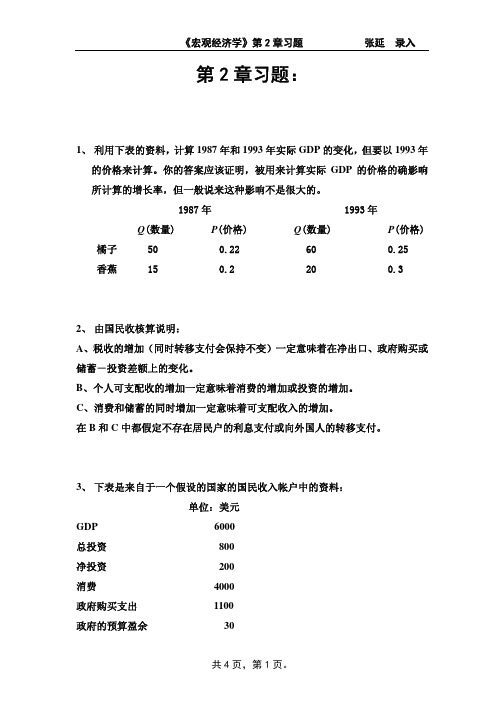
如果 c 1 就
按照下图 在这个例子中发生了什么 并且 它与我们课程中
的图形有什么重大的区别
共5页
第4页
宏观经济学
第三章作业题
张 延 录入
AD AD=AD0 + cY Y = AD
E
0
Yo
Y
14 我们在第 3 章第 4 节考察了开放经济 本习题提前就该内容进行一些讨论 本习题是较难的 有余力的学生才须尝试一下 请你按以下要求去推导一些结论 首先 我们假定外国对我们产品的需求是给定的 为 X 我们对外国产品的需求 或进口用 Q 表示 出口 X 它是一个关于收入的线性函数 进口 Q Qo mY 其中 m 是边际进口倾向
4
a 利用边际消费倾向 c 和边际储蓄倾向 s 相互之间的关系 将乘数等式以术 语 s 的形式 而不是术语 c 的形式写出
共5页 第1页
宏观经济学
第三章作业题
张 延 录入
b 当政府加入之后 乘数发生什么变化 你在 4 a 中推导出的公式是否 仍然适用 并加以解释
5 本题与所谓的节俭的悖论有关 并 且 I计 Io a 画一张图
共 4 页,第 4 页。
宏观经济学
第三章作业题
张 延 录入
第 3 章习题
1 关于在本章第 2 节中所考察的无政府条件下两部门产品市场的模型 我们在此 给出一个具体的例子加以研究 假定消费函数为 C=100+0.8Y 同时 投资 I=50 a b c 什么是这个事例中的均衡的收入水平 什么是均衡时的储蓄水平 如果由于某种原因产出水平是 800 那么 那么 什么是非意愿存货水平
(a) 定义消费价格指数。 (b) 假设定义 CPI 的商品篮子如上表所给定的。如果 1994 年的价格为:食品 每单位 30 美元;住房每单位 20 美元;娱乐每单位 6 美元。计算 1994 年 的 CPI。 (c) 说明相对于基年的 CPI 变化是所有单个价格变化的加权平均数,这些权 数是由基年中各种商品的支出份额所给定的。
中级微观经济学第四次作业+答案

中级微观经济学第四次作业+答案中级微观经济学第四次作业一、选择题1、(杨)如果一项投入品的平均产量高于其边际产量,则(B)A.随着投入的增加,平均产量将上升B.随着投入的增加,平均产量下降C.随着投入的增加,边际产量上升D.随着投入的增加平均产量可能上升也可能下降说明:每增加投入增加的产量小于平均产量,所以平均产量下降。
2、(杨)总产量曲线、平均产量曲线及边际产量曲线下降的先后顺序正确的是(D)A.总产量曲线平均产量曲线边际产量曲线B.边际产量曲线总产量曲线平均产量曲线C.平均产量曲线边际产量曲线总产量曲线D.边际产量曲线平均产量曲线总产量曲线说明:边际产量一直下降,低过平均产量后平均产量开始下降,当边际产量小于0之后总产量开始下降3、(杨)假设企业在维持产量不变的情况下,每增加一单位劳动投入量能减少4单位资本投入量,则边际替代率为(B)A.-0.25B.-4C.-0.5D.-2说明:根据公式计算4、(杨)假设规模报酬不变,单位时间内增加5%的劳动使用量,但资本保持不变,则产出将(C)A.增加5%B.增加大于5%C.增加小于5%D.减少5%说明:边际产量下降。
5、(崔)考虑生产函数f(x1,x2)=x12x22,该生产函数属于规模报酬(B)A.不变B.递增C.递减D.不确定说明:由规模报酬公式。
6、(崔)两种生产要素x1和x2的技术替代率为-4。
如果你想继续生产原来的产量,而且你将x1减少了3单位,那么你需要多少单位的x2?(C)A.16B.8C.12D.0说明:技术替代率7、(崔)在短期,可变要素1的最优数量和固定要素2的价格(B)A.有关B.无关C.不确定D.以上都不对说明:固定要素是沉没成本。
8、(崔)如果pMP1>w1,企业会增加还是减少要素1的投入量(A)。
A. 增加B. 减少C. 不变D. 先增加再减少说明:利润最大化条件。
9、(刘)为实现利润最大化,厂商选择(A)以使收入与成本之间的差额最大,即当边际收益等于边际成本时可以使利润达到最大。
【精选】宏观经济学作业四及答案
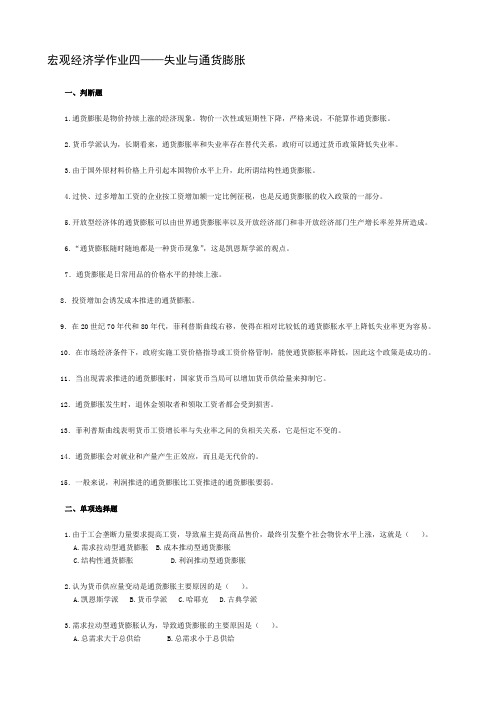
11.当出现需求推进的通货膨胀时,国家货币当局可以增加货币供给量来抑制它。
12.通货膨胀发生时,退休金领取者和领取工资者都会受到损害。
13.菲利普斯曲线表明货币工资增长率与失业率之间的负相关关系,它是恒定不变的。
2.认为货币供应量变动是通货膨胀主要原因的是()。
A.凯恩斯学派B.货币学派C.哈耶克D.古典学派
3.需求拉动型通货膨胀认为,导致通货膨胀的主要原因是()。
A.总需求大于总供给B.总需求小于总供给
C.消费支出增加D.商品、劳务共给过多
4.以下那种现象不伴随通货紧缩发生()。
A.有效需求不足B.经济衰退C.失业率下降D.物价下跌
三、名词解释
1.失业率:是指劳动大军中没有工作而又在寻找工作的人所占的比例,失业率的波动反映了就业的波动情况。
2.摩擦性失业:是指在生产过程中由于难以避免的原因而造成的短期局部性失业。即使劳动力市场处于均衡或充分就业状态,仍然存在着一定程度的失业。
3.结构性失业:是指劳动力需求与供给不匹配所造成的失业。其特点是既有失业,又有职位空缺,失业者或者没有合适的技能,或者居住地不当,无法填补现有的职位空缺。
5.开放型经济体的通货膨胀可以由世界通货膨胀率以及开放经济部门和非开放经济部门生产增长率差异所造成。
6.“通货膨胀随时随地都是一种货币现象”,这是凯恩斯学派的观点。
7.通货膨胀是日常用品的价格水平的持续上涨。
8.投资增加会诱发成本推进的通货膨胀。
9.在20世纪70年代和80年代,菲利普斯曲线右移,使得在相对比较低的通货膨胀水平上降低失业率更为容易。
B.通常用于描述某种总需求的增长引起的价格波动
宏微观经济学作业(四)参考答案

《宏微观经济学》作业(四)参考答案计算题:1、解:(1)GDP=工资+利息+租金+利润=100+10+30+30=170(亿元)(2)GDP=C+I+G+(X-M)=90+60+30+(60-70)=170(亿元)(3)净出口=X-M=60-70= -10(亿元)2、解:(1)国民收入=雇员佣金+企业支付的利息+个人租金收入+公司利润+非公司企业主收入=2856.3+274.9+43.2+184.5+98.3=3457.2(10亿人民币)(2)国内生产净值=国民收入+间接税=3457.2+365.3=3822.5(10亿人民币)(3)国内生产总值=国民生产净值+资本消耗补偿=3822.5+256.4=4078.9(10亿人民币)(4)个人收入=国民收入-(公司利润+社会保险金)+政府支付的利息+政府转移支付+红利=3457.2-(184.5+242)+111.4+245.6+55.5=3443.2(10亿人民币)(5)个人可支配收入=个人收入-个人所得税=3443.2-422.2=3021(10亿人民币)(6)个人储蓄=个人可支配收入-消费者支付的利息-个人消费支出=3021-43.2-2334.6=643.2(10亿人民币)3、解:Y=C+I+G=80+0.75[Y-(-20+0.2Y)]+50+0.1Y+200均衡的国民收入Y=1150税收T=-20+0.2Y=210消费C=80+0.75Yd=80+0.75*(1150-210)=785投资I=50+0.1Y=165K=3.3)1.08.075.0(11=+⨯-=∂∂I Y4、解:(1)边际消费倾向为0.65,边际储蓄倾向为0.35。
(2)Y=C+I+G=40+0.65Y+20+0.15Y+60均衡国民收入Y=600消费C=40+0.65Y=430投资I=20+0.15Y=110(3)5)65.015.0(11=+-=∂∂=I Y K5、解:产品市场均衡条件为:I = S ;货币市场均衡条件为:L = M /P 。
亚伯《中级宏观经济学》配套题库-课后习题(消费、储蓄与投资)【圣才出品】
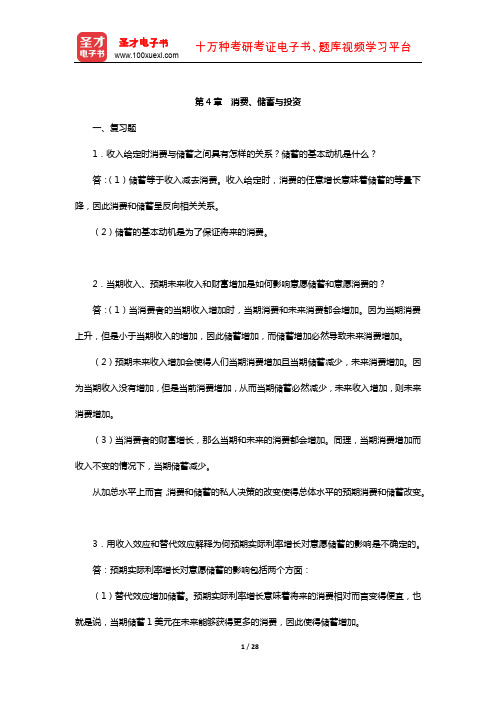
第4章消费、储蓄与投资一、复习题1.收入给定时消费与储蓄之间具有怎样的关系?储蓄的基本动机是什么?答:(1)储蓄等于收入减去消费。
收入给定时,消费的任意增长意味着储蓄的等量下降,因此消费和储蓄呈反向相关关系。
(2)储蓄的基本动机是为了保证将来的消费。
2.当期收入、预期未来收入和财富增加是如何影响意愿储蓄和意愿消费的?答:(1)当消费者的当期收入增加时,当期消费和未来消费都会增加。
因为当期消费上升,但是小于当期收入的增加,因此储蓄增加,而储蓄增加必然导致未来消费增加。
(2)预期未来收入增加会使得人们当期消费增加且当期储蓄减少,未来消费增加。
因为当期收入没有增加,但是当前消费增加,从而当期储蓄必然减少,未来收入增加,则未来消费增加。
(3)当消费者的财富增长,那么当期和未来的消费都会增加。
同理,当期消费增加而收入不变的情况下,当期储蓄减少。
从加总水平上而言,消费和储蓄的私人决策的改变使得总体水平的预期消费和储蓄改变。
3.用收入效应和替代效应解释为何预期实际利率增长对意愿储蓄的影响是不确定的。
答:预期实际利率增长对意愿储蓄的影响包括两个方面:(1)替代效应增加储蓄。
预期实际利率增长意味着将来的消费相对而言变得便宜,也就是说,当期储蓄1美元在未来能够获得更多的消费,因此使得储蓄增加。
(2)收入效应可能会增加或减少储蓄。
对借款者而言,预期实际利率的增长意味着他的境况会变好,使得借款者增加当期的消费,从而减少储蓄。
然而,对于借款者而言,面临一个更高的实际利率,会使得其境况变差,从而减少当期消费,增加储蓄。
收入效应作用的方向取决于消费者的初始禀赋状况。
总体而言,借款者的收入效应和替代效应呈反方向变动,因此预期实际利率增长对意愿储蓄的影响是不确定的。
而对贷款者而言,收入效应和替代效应是同方向变动的,即意愿储蓄会增加。
4.什么是预期税收实际利率?如果利息税降低,预期税后实际利率会发生怎样的变化?答:(1)预期税后实际利率能够有效地衡量储蓄者的收益率,它充分反映了税收对收益的影响。
宏观经济学第四章习题及答案

第四单元财政政策与货币政策本单元所涉及到的主要知识点:1.宏观经济政策目标及其种类;2.财政制度及其自动稳定器;3.财政政策与“挤出效应”;4.平衡预算、功能财政与赤字对经济的影响;5.货币乘数;6.货币政策工具与货币政策;7.财政政策与货币政策的组合及其效果比较;一.单项选择1.扩张性财政政策的本质是D ;a.货币供给扩张; b.政府规模扩大;c.物价更稳定; d.增加GDP;2.紧缩性财政政策的本质是D ;a.货币供给紧缩; b.政府规模缩小;c.实现物价稳定; d.减少GDP;3.以下 D不能视为自动稳定器;a.失业救济; b.累进税;c.社会保障; d.国防开支;4.财政盈余与 B对均衡GDP水平的影响效果相同;a.储蓄减少; b.储蓄增加;c.消费增加; d.投资增加;5.投资支出急剧减少的情况下,为保证经济维持在充分就业状态政府应C ;a.使税收和政府支出相等; b.使税收超过政府支出;c.使政府支出超过税收; d.提高税率;6.如果社会总需求的构成是消费1000亿元,投资400亿元,净出口100亿元,政府购买支出200亿元;充分就业的GDP为1200亿元;为使价格水平保持稳定政府应 A ;a.提高税率,并减少政府支出;b.通过降低政府债券的利息率来减少私人储蓄;c.增加政府支出;d.通过降低公司所得税率来鼓励私人投资;7.经济处于严重衰退时,适当的经济政策应当是 B ;a.减少政府支出; b.降低利息率;c.使本国货币升值; d.提高利息率;8.下列叙述中A 是正确的;a.内在稳定器能部分地抵消经济波动;b.内在稳定器无法缓解失业;c.内在稳定器可以完全抵消任何经济波动;d.以上都不对;9.拉弗曲线表明 D ;a.税率越高,总税收额越高; b.税率越高,总税收额越低;c.税率与总税收额之间不相关; d.某一税率水平上税收总额最大; 10.以下 A 的财政政策是彻底反周期波动的;a.经济衰退时增加政府开支削减税收;b.经济高涨时增加政府开支削减税收;c.经济高涨时增加政府开支提高税收;d.经济衰退时减少政府开支削减税收;11.在下述C 情况下将发生挤出效应;a.货币供给的下降使利率提高;b.私人部门税收的增加引起私人部门可支配收入和支出的下降;c.政府支出增加使利率提高;d.政府支出的下降导致消费支出的下降;12.在下述D 情况下挤出效应显着;a.货币需求对利率敏感.投资支出对利率也敏感;b.货币需求对利率不敏感.投资支出对利率也不敏感;c.货币需求对利率敏感.投资支出对利率不敏感;d.货币需求对利率不敏感.投资支出对利率敏感;13.如果政府购买支出的增加与转移支付的减少相等,收入水平的变动情况是 B ; a.不变; b.增加;c.减少; d.无法确定;14.比例税率既定,在其他条件不变的情况下,增加自主投资会使政府预算B ;a.保持平衡; b.产生盈余c.出现赤字; d.以上都有可能15.如果不考虑比例税,平衡预算乘数等于A ;a.1 ; b.0;c.2; d.1/c;16.货币乘数大小与以下 D 变量有关;a.法定准备率; b.超额准备率;c.现金存款比例; d.以上都是;17.货币政策指中央银行为实现既定的经济目标,运用各种工具调节 A 的一种金融政策和措施;a.货币供给和利率; b.货币需求与利率;c.货币需求与供给; d.货币流通速度;18.西方国家中央银行最经常使用、最灵活有效的货币政策手段是 C ;a.法定存款准备金; b.再贴现率;c.公开市场业务; d.道义劝告;19.中央银行有多种职能,只有 D 不是其职能;a.制定货币政策; b.为商业银行保存储备金;c.发行货币; d.为政府创造利润;20.法定准备率高低和存款种类的关系是B ;a.定期存款的准备率高于活期存款; b.定期存款的准备率低于活期存款; c.准备率高低与存款期限无关; d.以上都有可能;21.中央银行影响商业银行从中央银行贷款数量的传统货币政策手段是B ;a.公开市场业务; b.再贴现率;c.道义劝告; d.法定存款准备金;22.中央银行影响商业银行放贷数量的传统货币手段是 A ;a.法定存款准备金; b.公开市场业务;c.道义劝告; d.以上都不是;23.中央银行在公开市场上卖出政府债券的主要意图是 C ;a.弥补财政赤字; b.减少商业银行在中央银行的存款;c.减少流通中基础货币; d.通过买卖债券获取差价利益;24.中央银行在公开市场上买进政府债券的结果是C ;a.银行存款减少; b.市场利率上升;c.公众手里的货币增加; d.以上都不是;25.中央银行最常用的政策工具是B ;a.法定准备率; b.公开市场业务;c.再贴现率; d.道义劝告;26.货币政策的主要内容是货币政策的目标.货币政策工具以及 B a.货币政策调整机制; b.货币政策传导机制;c.货币政策监督机制; d.货币政策反映机制;27.下列 B 不是货币政策工具;a.公开市场业务; b.税率;c.法定准备金率; d.再贴现率;28.对于增加或减少社会总需求而言下列 A 相互抵触;a.增税和增加货币供给; b.减税和增加货币供给; c.减少政府支出和减少货币供给;d.增税和提高利息率; 29.缓解需求拉上型通货膨胀压力的正确措施是A;a.卖出政府证券,提高法定准备金率,并提高再贴现率;b.购买政府证券,提高法定准备金率,并提高再贴现率;c.卖出政府证券,降低法定准备金率,并降低再贴现率;d.卖出政府证券,提高法定准备金率,并降低再贴现率; 30.货币需求量超过货币供给量将导致C ;a.货币需求曲线会左移动; b.货币供给曲线会右移动 c.利息率上升; d.利息率下降31.其他条件不变的情况下,货币供给增加将导致 B ;a.利息率和均衡GDP水平降低;b.利息率降低和均衡GDP水平提高;c.利息率和均衡GDP水平提高;d.利息率提高和均衡GDP水平降低;32.公开市场业务是指D ;a.商业银行的信贷活动;b.商业银行在公开市场上买进或卖出政府债券;c.中央银行增加或减少对商业银行的贷款;d.中央银行在公开市场上买进或卖出政府债券;33.中央银行提高再贴现率将导致 B ;a.货币供给量增加,利息率提高;b.货币供给量减少,利息率提高;c.货币供给量增加,利息率降低;d.货币供给量减少,利息率降低;34.财政政策扩张性最显着的是 C;a.减税100亿元; b.增税100亿元;c.增加政府支出100亿元; d.减少政府支出100亿元;35.货币供给增加使LM曲线右移,在 C 情况下均衡收入变动接近于LM曲线的移动量; a.LM曲线.IS曲线一样陡峭; b.LM曲线和IS曲线一样平缓;c.LM曲线陡峭.IS曲线平缓; d.LM曲线平缓.IS曲线陡峭;36.在 C 情况下增加货币供给不会影响均衡收入的大小;a.LM曲线和IS曲线一样平缓; b.LM曲线和IS曲线一样陡峭;c.LM曲线平缓.IS曲线垂直; d.LM曲线垂直.IS曲线平缓;37.政府购买增加使IS曲线右移,在 A 情况下均衡收入变动接近于IS曲线的移动量;a.LM曲线平缓.IS曲线陡峭; b.LM曲线垂直.IS曲线陡峭;c.LM曲线和IS曲线一样平缓; d.LM曲线陡峭.IS曲线平缓;38.在A 情况下货币供给的变动对均衡收入有更显着的影响;a.投资对利率更敏感; b.投资对利率不敏感;c.乘数较小; d.以上都不是;39.根据凯恩斯的观点,衰退时货币政策无效是因为B ;a.货币需求和投资都相对有弹性;b.货币需求相对有弹性,投资相对无弹性;c.货币需求和投资需求都相对无弹性;d.货币需求相对无弹性,投资相对有弹性;40.某封闭性经济的MPS为0.1,在 B 情况下政府可以将总需求曲线向右移动400亿元; a.增加政府支出400亿元; b.增加政府支出40亿元;c.减税40亿元; d.增税40亿元;41.某封闭经济的MPC为0.8,在 C 情况下政府可以将总需求曲线向右移动1000亿元; a.增加政府支出250亿元; b.增加政府支出800亿元;c.减税250亿元; d.减税1000亿元;42.在A 情况下财政政策稳定经济的效果最佳;a.衰退期间增加G减少T,通货膨胀时减少G增加T;b.保持预算平衡;c.通货膨胀期间产生财政赤字,衰退期间发生财政盈余;d.保持财政盈余;43.在 A 情况下货币政策对均衡GDP的影响最大;a.货币需求曲线越陡,投资需求曲线平缓,MPC大;b.货币需求曲线平缓,投资需求曲线越陡,MPC大;c.货币需求曲线和投资需求曲线平缓,MPC大;d.货币需求曲线和投资需求曲线陡峭,MPC小;44.在 B 的情况下扩张的货币政策效果将受到削弱;a.货币需求曲线向左移动; b.投资需求曲线向左移动;c.储蓄曲线向下移动; d.投资需求曲线向右移动; 45.在 C 的情况下紧缩的货币政策效果将受到削弱;a.企业对未来利润状况预期悲观; b.出现财政盈余; c.货币流通速度上升; d.货币流通速度下降; 46. A将减弱紧缩货币政策的效果;a.实际利率低; b.名义利率低;c.实际利率高; d.名义利率高;47.“双松政策”使GDP A ;a.增加较多; b.增加较少;c.减少较多; d.减少较少;48.“双紧政策”使利息率 D ;a.提高; b.下降;c.不变; d.以上都有可能;49.“松货币紧财政”使利息率 C ;a.提高很多; b.提高很少;c.下降很多; d.下降很少;50.“松财政紧货币”使国民收入 D;a.增加; b.减少;c.不变; d.以上都有可能;二、多项选择1.宏观经济政策的主要目标是 ABCD ;a.充分就业; b.物价稳定;c.经济增长; d.国际收支平衡;2.在不考虑对外经济交往的情况下,宏观经济政策工具常用的有 CD 政策;a.生产管理; b.消费管理;c.供给管理; d.需求管理;3.需求管理政策包括 AB ;a.财政政策;b.货币政策;c.收入政策;c.人力政策;4.供给管理政策包括 CD ;a.财政政策;b.货币政策;c.收入政策;d.人力政策;5.在凯恩斯主义出现之后,财政政策被作为需求管理的重要工具;这种政策包含有 BCD ; a.收入政策;b.开支政策;c.税收政策;d.赤字政策;6.属于内在稳定器的项目是BCD ;a.政府购买; b.累进税;c.社会保障; d.政府转移支付;7.财政政策工具包括 AC ;a.税收; b.公开市场业务;c.政府支出; d.再贴现率;8.政府支出包括 ABC ;a.公共工程支出; b.政府日常购买;c.转移支付; d.税收;9.在执行货币政策过程中,中央银行运用各种工具通过调节 AB来实现既定的经济目标;a.货币供给; b.利率;c.货币需求; d.有价证券价格;10.货币政策内容包括 ACD ;a.货币政策的目标; b.货币政策中介;c.货币政策传导机制; d.货币政策工具;11.可以列入货币政策目标的有 BCD ;a.人均收入提高; b.稳定币值和物价;c.充分就业; d.经济增长;12.以下ABD 属于货币政策工具;a.道义劝告; b.公开市场业务;c.行政干项; d.法定准备金率;13.中央银行可能影响商业银行贷款能力的传统货币手段是 AD ; a.法定准备金率; b.公开市场业务;c.道义劝告; d.再贴现率;14.应对经济萧条的适当货币政策是 BD ;a.提高商业银行准备金率;b.中央银行在公开市场买进政府债券;c.中央银行在公开市场卖出政府债券;d.降低再贴现率;15.货币政策和财政政策在配合上可以构成的政策组合有 ABCD ;a.松的货币政策和松的财政政策;b.紧的货币政策和紧的财政政策;c.松的货币政策和紧的财政政策;d.紧的货币政策和松的财政政策;16.当宏观经济处于严重萧条的情况时,政府不适宜选择BCD 的政策搭配;a.松的财政政策与松的货币政策;b.松的财政政策与紧的货币政策;c.紧的财政政策与紧的货币政策;d.紧的财政政策与松的货币政策;17.若经济处于凯恩斯区域,实施扩张性的财政政策,将会 AD;a.增加收入;b.降低利率;c.减少收入;d.利率不变;18.若经济处于古典区域,实施扩张性的货币政策,将会 AD ;a.增加收入;b.降低利率;c.减少收入;d.提高利率;三、名词解释1.财政政策;2.功能财政;3.补偿性财政政策;4.自动稳定器;5.挤出效应;6.拉弗曲线;7.财政政策乘数;8.流动性陷阱; 9.货币政策;10.存款准备金;11.再贴现率;12.公开市场业务;13.货币幻觉;14.货币政策乘数;四、判断题1.宏观经济的主要目标之间具有冲突性;2.充分就业和物价稳定是一致的,两个目标一定可以同时实现;3.按照凯恩斯主义,政府的财政预算应该保持稳定;4.内在稳定器与自主财政政策的作用效果是相同的;5.转移支付不是财政政策工具,而是收入政策的手段;6.凯恩斯主义所重视的政策工具是收入管理;7.松的财政政策的内涵是货币供给的增加;8.由于货币的流通性强,所以财政政策对收入影响的效果不如货币政策;9.货币交易需求反映了货币作为交换媒介的职能;10.超额准备金是指法定准备金超过实际准备金的金额;11.当公众从中央银行手中购买政府证券时,货币供给增加;12.松的货币政策会减少货币供给;13.利息率的改变对投资支出的影响大于对消费支出的影响;14.当充分就业预算盈余时实际预算可能存在赤字;15.拉弗曲线表明税率为50%时税收总额最大;16.由于商业银行的独立性,中央银行的道义劝告不起作用;17.存在货币投机需求的流动性陷阱时,财政政策的挤出效应最小;18.财政政策虽然具有挤出效应,但对于总收入而言其效果可以比货币政策明显; 19.投资预期比较悲观的情况下,财政政策的效果将削弱;20.对于“滞涨”问题,传统凯恩斯主义无能为力;五、辨析题1.不同的政策工具可以达到相同的政策目标;2.财政政策属于需求管理,货币政策属于供给管理;3.扩张性的财政政策包括增加政府支出和增税;4.紧缩的财政政策可能使GDP减少,也可能使GDP不变;5.累进税下,税收收入在经济扩张时期会自动减少,而在经济衰退时期会自动增加;6.内在稳定器能够消除经济萧条和通货膨胀;7.实施功能财政政策的结果是实现了经济周期中的政府收支平衡;8.政府的扩张财政政策一定会产生挤出效应9.通过增加税收来弥补扩张财政政策带来的赤字,如果税收增量由企业或个人原先储蓄转化而来,那么这方面的挤出效应是不存在的;10.通过向商业银行或公众出售债券来弥补扩张财政政策带来的赤字,不会产生挤出效应; 11.减税的同时,政府通过借债或增发货币来弥补财政赤字对扩张的影响一样;12.如果边际消费倾向为,则政府减税100可使总需求曲线向右移动400;13.其他条件不变,当公众从中央银行购买政府证券时,货币供给增加;14.实际准备金等于法定准备金加上超额准备金;15.其他条件不变时,投资需求曲线越平坦,货币政策的效果越不明显;16.其他条件不变,货币投机需求曲线越平坦,货币政策的效果越不明显;17.凯恩斯主义和货币主义的货币政策是相同的;六、简答题1.简述货币政策的目标以及他们之间的相互关系;2.平衡预算的财政思想和功能财政思想有何主要区别3.简述政府公债对国民经济的影响;4.什么是斟酌使用的财政政策5.政府削减税收,在运用货币政策保持利率不变与货币存量不变这两种情况下减税的经济后果有什么区别6.什么是货币创造乘数其大小主要和哪些变量有关7.中央银行货币政策的主要工具有哪些8.什么是公开市场业务这一货币政策工具有哪些优点9.什么是斟酌使用的货币政策10.简述货币政策传导过程11.假定经济起初处于充分就业状态,现在政府要改变总需求构成,增加私人投资而减少消费支出, 但不改变总需求水平,试问应当实行何种政策组合12.在何种情况下应较多地运用财政政策来调节国民经济13.在何种情况下应较多地运用货币政策来调节国民经济14.若经济进入“凯恩斯陷阱”,应当采取何种政策为什么15.若经济处于“古典区域”,应该采取何种政策为什么16.简述财政政策及其局限性;17.如何搭配财政政策和货币政策来克服“滞胀”;18.什么是宏观经济政策的内部时滞19.简单说明货市幻觉及其抵消费的影响;20.假设政府考虑用两种扩张政策,一是直接增加财政支出,另一种是降低税率;简要分析这两种政策对收入、利率和投资的影响;21.什么是充分就业预算盈余它在制定经济政策中的意义是什么22.什么是基础货币23.什么是再贴现率24.简述货币政策传导机制;25.简述相机抉择的涵义;26.什么是单一货币规则27.简述公开市场操作及其优点;28.简要说明评价宏观经济政策工具好坏的现实标准;29.货币政策主要有哪些目标选择准则;七、论述题1.什么是自动稳定器以税收制度为例说明自动稳定器的作用;2.论述中央银行的货币政策主要工具及其作用;3.论述财政政策与货币政策相互配合的必要性;4.怎样正确认识凯恩斯的宏观经济政策理论5.论述财政政策的作用大小与IS和LM曲线斜率的关系;6.论述货币政策的作用大小与IS和LM曲线斜率的关系;7.如何配合使用货币政策和财政政策有效地克服经济下滑8.什么是自动稳定器自动稳定器的功能如何实现9.试评凯恩斯宏观经济理论的贡献;10.阐述为什么凯恩斯主义强调财政政策而货币主义者强调货币政策;11.联系实际阐述微观主体的预期对货币政策的抵消作用;八、计算题1.假设货币需求L=-5r,货币供给M=100;计算:a.LM曲线方程b.当消费C=40+、投资I=140-10r、税收T=50、政府支出G=50时的均衡收入、利率以及投资;c.当消费C=40+、投资I=110-5r、税收T=50、政府支出G=50时的均衡收入、利率和投资;d.政府支出从50美元增加到80美元时,a和b条件下的均衡收入和利率;e.政府支出从50美元增加到80美元时,a和b条件下的均衡收入的增量;2.已知货币需求为L=、货币供给M=200、消费C=90+、税收T=50、投资I=140-5r、政府支出G=50;计算:a.IS曲线和LM曲线方程b.均衡收入、均衡利率以及投资;c.政府支出增加20时候的均衡收入、均衡利率以及投资;d.挤出效应;3.假设货币需求L=-10r,货币供给M=200,消费C=60+,税收T=100,投资I=150,政府支出G=100;计算a.IS曲线和LM曲线方程;b.均衡收入、均衡利率以及投资;c.政府支出从100美元增加到120美元时的均衡收入、均衡利率以及投资;d.挤出效应4.已知货币需求L=-4r,货币供给M=150;计算:a.LM曲线方程;b.IS曲线方程Y=1250-30r时,均衡收入和均衡利率;c.IS曲线方程Y=1100-15r时,均衡收入和均衡利率;d.货币供给增加20时,b和c条件下的均衡收入和均衡利率;5.假定两部门经济中IS曲线方程Y=1250-30r;计算:a.货币供给M=150,货币需求L=-4r时,均衡收入和均衡利率;b.货币供给M=150,货币需求L=-时,均衡收入和均衡利率;c.货币供给增加为M=170,在b和c货币需求条件下,均衡收入和均衡利率;=,边际税率t=;计6.假设消费C=100+,投资I=50,政府支出G=200,政府转移支付Tr算:a.均衡收入;b.预算盈余BS;c.投资增加到I=100时,预算盈余增量;7.假定政府当前预算赤字为75亿元,边际消费倾向c=,边际税率t=,政府为降低通货膨胀率减少政府支出200亿元;通过计算回答政府支出的变化能否消灭赤字;8.假定现金存款比为,法定准备金率为10%,超额准备金率8%;计算:a.货币创造乘数b.增加基础货币100亿元时,货币供给变动量;=,价格总水平9.三部门的经济中,已知边际消费倾向c=,边际税率t=,货币交易需求L1 P=1;计算:政府支出增加20亿元,保证利率水平不变时的货币供给增量;10.已知消费函数C=150+ Y,投资函数I=200-10r,货币供给M=180,货币交易需求L1=50-10r,计算:= Y,货币投机需求L2a.均衡收人、均衡利率以及投资;b.其他条件不变,边际消费倾向为时,维持投资量的货币供给增量;11.已知法定准备率是12%,没有超额准备金,对现金的需求为1000亿元;计算:a.总准备金400亿元时的货币供给量;b.题目中其他条件不变,法定准备率提高到时,货币供给的变动量;c.题目中其他条件不变,中央银行买进10亿元政府债券时,货币供给的变动量; 12.已知消费函数C=600+,投资函数I=400-50r,政府购买G=200,货币需求L=250+-125r,货币供给M=1250,充分就业国民收入Y=5000;计算:a.均衡收入和利率b.财政政策乘数和货币政策乘数;c.实现充分就业的政府购买支出增量;d.实现充分就业的货币供给增量;九、案例分析1.1998年初开始,中国经济进入了通货紧缩时期;国内需求不足、产品滞销与企业利润减少和紧缩开支之间相互影响,形成了恶性循环;从当年起,政府采取了一系列宏观经济措施;比较显着的变化是积极的财政政策,比如发行大量的国债,用来进行基础设施和其他方面的投资;到2000年初,经济增长速度下降的趋势开始反转,2000年GDP增长率恢复到8%的水平;有学者据此认为是积极的财政政策遏制了经济的下滑,也有的学者认为单一的需求管理政策不足以拉动经济增长;后者观点的合理性有哪些2.2000年下半年开始,美国经济开始减速,2000年第三季度GDP从上半年的5%以上降到%;股市下挫,特别是纳斯达克指数比最高点下调50%;美国家庭的财富总值55年来首次下降;截至2001年3月,美国主要汽车制造商在国内市场的销量连续六个月下降;2001年3月份的失业率达到%,为过去20个月以来的最高水平;2001年2月8日,美国总统布什向国会正式提交了关于10年内大幅减税万亿美元的计划,以兑现自己在竞选总统时向选民许下的诺言;减税计划的主要内容有:简化个人所得税制,将五档所得税体系15%、28%、31%、36%、%调整为四档10%、15%、25%、33%;将儿童课税扣除由每名儿童500美元加倍至1000美元;恢复双收入家庭10%的税收抵免;废除遗产税;扩大慈善捐助扣除的范围;使研究和实验的税收抵免永久化;减税计划的意图是什么能否实现其目的受到哪些因素影响3.近年来,中央经济工作会议不断提出继续实行稳健的货币政策;实施稳健的货币政策是从1997年亚洲金融危机后开始的,后来曾被写入政府工作报告;其主要原则是:灵活运用货币政策工具,适当增加货币供应量;及时调整信贷政策,引导贷款投向;实行全面的金融稳定计划;完善货币政策传导机制,发展货币市场;比如在货币供给方面,中央银行从1998年开始就采取了一系列举措,取消了对商业银行的贷款限额控制、两次下调法定存款准备金率、连续7次降低存贷款利率等;贯彻稳健的货币政策的意义是什么与扩张和紧缩相比稳健的货币政策的主要特征是什么第四单元财政政策与货币政策一.单项选择1.d; 2.d; 3.d; 4.b; 5.c; 6.a; 7.b; 8.a; 9.d; 10.a;11.c; 12.d; 13.b; 14.b; 15.a; 16.d; 17.a; 18.c; 19.d; 20.b;21.b; 22.a; 23.c; 24.c; 25.b; 26.b; 27.b; 28.a; 29.a; 30.c;31.b; 32.d; 33.b; 34.c; 35.c; 36.c; 37.a; 38.a; 39.b; 40.b;41.c; 42.a; 43.a; 44.b; 45.c; 46.a ; 47.a; 48.d; 49.c;50.d;二.多项选择1.abcd; 2.cd; 3.ab; 4.cd; 5.bcd; 6.bcd; 7.ac; 8.abc; 9.ab;10.acd; 11.bcd; 12.abd; 13.ad; 14.bd; 15.abcd; 16.bcd; 17.ad;18.ab;三、名词解释1.财政政策是指为促进就业水平提高,减轻经济波动,防止通货膨胀,实现稳定增长而对政府支出、税收和借债水平所进行的选择,或对政府收入和支出水平所作出的决策; 2.功能财政是指政府在财政方面的积极政策主要是为实现无通货膨胀的充分就业水平的产出和收入而努力,为实现这一目标时,预算可以是盈余,也可以是赤字;3.补偿性财政政策是指根据经济的萧条和繁荣状况交替使用扩张性和紧缩性财政政策; 4.自动稳定器是指经济系统本身存在的一种会减少各种干扰对国民收入冲击的机制,能够在经济繁荣时期自动抑制膨胀,在经济萧条时期自动减轻衰退,毋须政府采取任何行动; 5.挤出效应是指政府支出增加所引起的私人消费或投资降低的作用;6.拉弗曲线是指描绘税收与税率关系的曲线;一般情况下,税率越高,政府的税收就越多;但税率的提高超过一定的限度时,企业的投资减少,收入减少,即税基减小,反而导致政府的税收减少;。
宏观经济学课程第四次作业
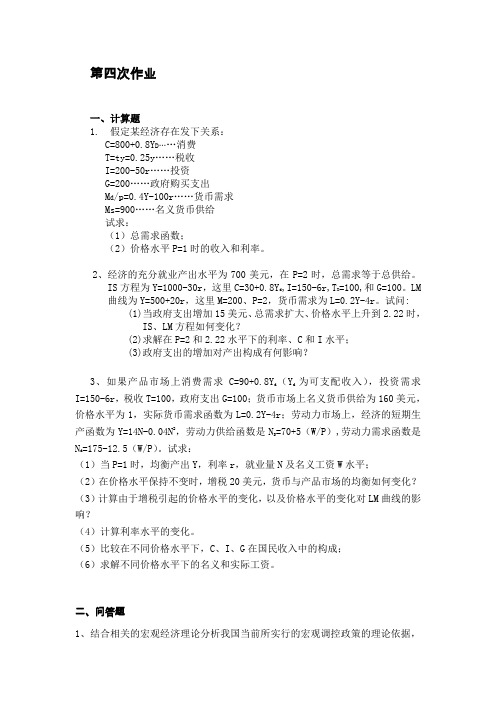
第四次作业一、计算题1. 假定某经济存在发下关系:C=800+0.8Y D……消费T=ty=0.25y……税收I=200-50r……投资G=200……政府购买支出M d/p=0.4Y-100r……货币需求Ms=900……名义货币供给试求:(1)总需求函数;(2)价格水平P=1时的收入和利率。
2、经济的充分就业产出水平为700美元,在P=2时,总需求等于总供给。
IS方程为Y=1000-30r,这里C=30+0.8Yd ,I=150-6r,TX=100,和G=100。
LM曲线为Y=500+20r,这里M=200、P=2,货币需求为L=0.2Y-4r。
试问:(1)当政府支出增加15美元、总需求扩大、价格水平上升到2.22时,IS、LM方程如何变化?(2)求解在P=2和2.22水平下的利率、C和I水平;(3)政府支出的增加对产出构成有何影响?3、如果产品市场上消费需求C=90+0.8Yd (Yd为可支配收入),投资需求I=150-6r,税收T=100,政府支出G=100;货币市场上名义货币供给为160美元,价格水平为1,实际货币需求函数为L=0.2Y-4r;劳动力市场上,经济的短期生产函数为Y=14N-0.04N2,劳动力供给函数是NS=70+5(W/P),劳动力需求函数是Nd=175-12.5(W/P)。
试求:(1)当P=1时,均衡产出Y,利率r,就业量N及名义工资W水平;(2)在价格水平保持不变时,增税20美元,货币与产品市场的均衡如何变化?(3)计算由于增税引起的价格水平的变化,以及价格水平的变化对LM曲线的影响?(4)计算利率水平的变化。
(5)比较在不同价格水平下,C、I、G在国民收入中的构成;(6)求解不同价格水平下的名义和实际工资。
二、问答题1、结合相关的宏观经济理论分析我国当前所实行的宏观调控政策的理论依据,并简要评论其实际效果。
2、“古典”模型中的总供给曲线和凯恩斯的总供给曲线有什么差别?为什么有这种差别?3、为什么总需求曲线向右下方倾斜?三、作图题:1、作图推导古典的总供给曲线;2、作图推导凯恩斯的总供给曲线;3、图示财政政策对总需求曲线的影响。
宏观经济学作业4
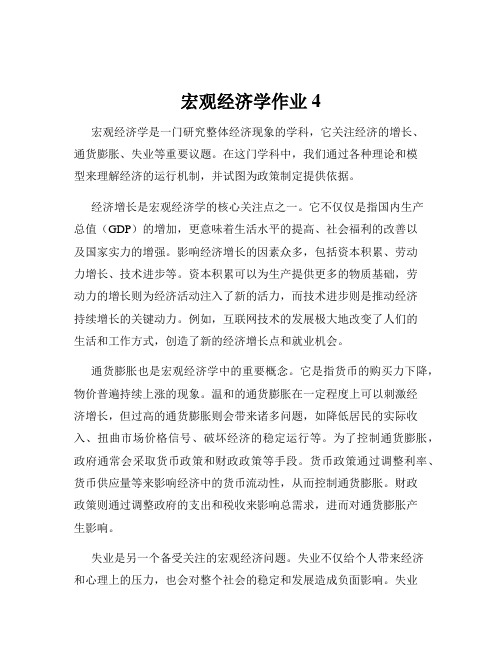
宏观经济学作业4宏观经济学是一门研究整体经济现象的学科,它关注经济的增长、通货膨胀、失业等重要议题。
在这门学科中,我们通过各种理论和模型来理解经济的运行机制,并试图为政策制定提供依据。
经济增长是宏观经济学的核心关注点之一。
它不仅仅是指国内生产总值(GDP)的增加,更意味着生活水平的提高、社会福利的改善以及国家实力的增强。
影响经济增长的因素众多,包括资本积累、劳动力增长、技术进步等。
资本积累可以为生产提供更多的物质基础,劳动力的增长则为经济活动注入了新的活力,而技术进步则是推动经济持续增长的关键动力。
例如,互联网技术的发展极大地改变了人们的生活和工作方式,创造了新的经济增长点和就业机会。
通货膨胀也是宏观经济学中的重要概念。
它是指货币的购买力下降,物价普遍持续上涨的现象。
温和的通货膨胀在一定程度上可以刺激经济增长,但过高的通货膨胀则会带来诸多问题,如降低居民的实际收入、扭曲市场价格信号、破坏经济的稳定运行等。
为了控制通货膨胀,政府通常会采取货币政策和财政政策等手段。
货币政策通过调整利率、货币供应量等来影响经济中的货币流动性,从而控制通货膨胀。
财政政策则通过调整政府的支出和税收来影响总需求,进而对通货膨胀产生影响。
失业是另一个备受关注的宏观经济问题。
失业不仅给个人带来经济和心理上的压力,也会对整个社会的稳定和发展造成负面影响。
失业可以分为摩擦性失业、结构性失业和周期性失业等不同类型。
摩擦性失业是由于劳动力市场的信息不对称和劳动力的流动造成的,通常是短期的。
结构性失业则是由于经济结构的调整,导致劳动力的技能和市场需求不匹配,这种失业可能会持续较长时间。
周期性失业则与经济周期密切相关,在经济衰退时往往会增加。
政府为了降低失业率,会采取一系列的政策措施,如提供职业培训、促进就业服务、扶持中小企业发展等。
在宏观经济中,政府的政策起着至关重要的作用。
财政政策和货币政策是政府调控经济的两大主要工具。
财政政策通过政府的支出和税收来影响经济。
华东理工大学中级宏观经济学作业4:货币政策 答案版

19.以下哪种政策组合会一致地起到增加货币供给的作用 D
A出售政府债券,降低法定准备金,降低贴现率
B出售政府债券,提高法定准备金,提高贴现率
C购买政府债券,提高法定准备金,降低贴现率
D购买政府债券,降低法定准备金,降低贴现率
20.假设名义利率和实际利率不符,那么 B
A.货币需求取决于实际利率 B。消费取决于实际利率
C.公众支付习惯 D.物价和劳务的相对价格
4.如果我们知道,利率由3%提高到3.6%,货币需求减少了2%。那么现在利率由8%提高到9.6%,我们预期货币需求会: C
A。减少2% B。减少不到2% C。减少超过2% D。增加超过2%
5.当一国经济出现通货膨胀时,货币当局可以通过(B)的方法减少货币供给。
b.在新凯恩斯模型中,名义货币量的变化有实际影响,名义货币增加使实际经济扩张,名义货币减少使实际经济紧缩。在该模型中,生产者之间的不完全竞争使货币产生非中性。
c.粘性价格对于已经变化的情况不能迅速作出反应的商品名义价格。其解释依据有两点:一是典型的生产者制定价格;二是存在菜单成本,生产者不愿意改变价目表。
d.新凯恩斯模型预期实际工资率的变化是顺周期的,而劳动平均产品的变化是逆周期性的。实际工资率的预期和数据是一致的,但劳动平均产品的预期和数据不一致,数据表明劳动平价产品变化有弱的顺周期性。
e.在新凯恩斯模型中,货币供给冲击不是唯一有实际影响的冲击。在粘性价格条件下,人们的收入发生改变的冲击都可能产生实际影响,例如,公众预期经济将会以更快的速度发展、新发现巨大的矿产资源等。
6.假定价格如实际经济周期理论所描述的具有完全的伸缩性,另外产出波动如RBC中完全由技术冲击引起。
(1)假定央行保持货币供给不变,当产出波动时,物价水平如何变化?
宏观经济学作业四及答案
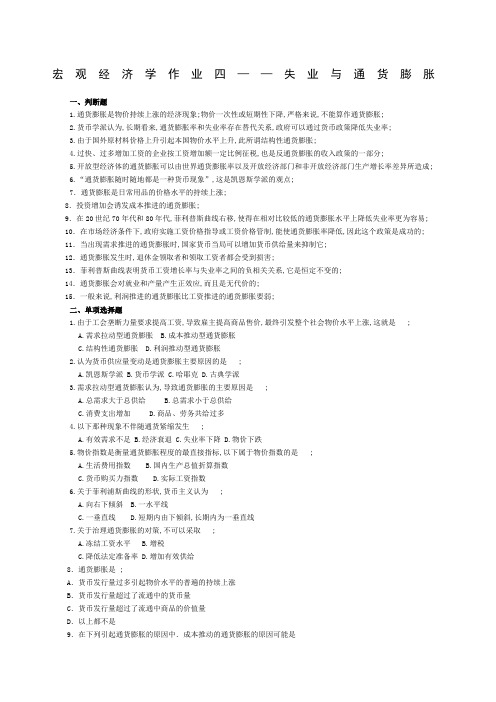
宏观经济学作业四——失业与通货膨胀一、判断题1.通货膨胀是物价持续上涨的经济现象;物价一次性或短期性下降,严格来说,不能算作通货膨胀;2.货币学派认为,长期看来,通货膨胀率和失业率存在替代关系,政府可以通过货币政策降低失业率;3.由于国外原材料价格上升引起本国物价水平上升,此所谓结构性通货膨胀;4.过快、过多增加工资的企业按工资增加额一定比例征税,也是反通货膨胀的收入政策的一部分;5.开放型经济体的通货膨胀可以由世界通货膨胀率以及开放经济部门和非开放经济部门生产增长率差异所造成;6.“通货膨胀随时随地都是一种货币现象”,这是凯恩斯学派的观点;7.通货膨胀是日常用品的价格水平的持续上涨;8.投资增加会诱发成本推进的通货膨胀;9.在20世纪70年代和80年代,菲利普斯曲线右移,使得在相对比较低的通货膨胀水平上降低失业率更为容易;10.在市场经济条件下,政府实施工资价格指导或工资价格管制,能使通货膨胀率降低,因此这个政策是成功的;11.当出现需求推进的通货膨胀时,国家货币当局可以增加货币供给量来抑制它;12.通货膨胀发生时,退休金领取者和领取工资者都会受到损害;13.菲利普斯曲线表明货币工资增长率与失业率之间的负相关关系,它是恒定不变的;14.通货膨胀会对就业和产量产生正效应,而且是无代价的;15.一般来说,利润推进的通货膨胀比工资推进的通货膨胀要弱;二、单项选择题1.由于工会垄断力量要求提高工资,导致雇主提高商品售价,最终引发整个社会物价水平上涨,这就是 ;A.需求拉动型通货膨胀B.成本推动型通货膨胀C.结构性通货膨胀D.利润推动型通货膨胀2.认为货币供应量变动是通货膨胀主要原因的是 ;A.凯恩斯学派B.货币学派C.哈耶克D.古典学派3.需求拉动型通货膨胀认为,导致通货膨胀的主要原因是 ;A.总需求大于总供给B.总需求小于总供给C.消费支出增加D.商品、劳务共给过多4.以下那种现象不伴随通货紧缩发生 ;A.有效需求不足B.经济衰退C.失业率下降D.物价下跌5.物价指数是衡量通货膨胀程度的最直接指标,以下属于物价指数的是 ;A.生活费用指数B.国内生产总值折算指数C.货币购买力指数D.实际工资指数6.关于菲利浦斯曲线的形状,货币主义认为 ;A.向右下倾斜B.一水平线C.一垂直线D.短期内由下倾斜,长期内为一垂直线7.关于治理通货膨胀的对策,不可以采取 ;A.冻结工资水平B.增税C.降低法定准备率D.增加有效供给8.通货膨胀是 ;A.货币发行量过多引起物价水平的普遍的持续上涨B.货币发行量超过了流通中的货币量C.货币发行量超过了流通中商品的价值量D.以上都不是9.在下列引起通货膨胀的原因中.成本推动的通货膨胀的原因可能是A.银行贷款的扩张 B.预算赤字C.进口商品价格上涨 D.投资增加10.通货膨胀会 ;A.使国民收入提高到超过其正常水平B.使国民收入下降到超过其正常水平C.使国民收入提高或下降主要看产生这种通货膨胀的原因D.只有在经济处于潜在的产出水平时,才会促进国民收入增长11.需求拉动的通货膨胀 ;A.通常用于描述某种供给因素所引起的价格波动B.通常用于描述某种总需求的增长引起的价格波动C.表示经济制度已调整过的预期通货膨胀率D.以上都不是12.成本推进的通货膨胀 ;A.通常用于描述某种供给因素所引起的价格波动B.通常用于描述某种总需求的增长所引起的价格波动C.表示经济制度已调整过的预期通货膨胀率D.以上都不是13.通货膨胀的收入分配效应是指;A.收入普遍上升 B.收入普遍下降C.收入结构变化 D.债权人收入上升14.抑制需求拉动的通货膨胀,应该;A.控制货币供应量 B.降低工资C.解除托拉斯组织 D.减少税收15.为减少经济中存在的失业,应采取的财政政策工具是 ;A.增加政府支出 B.提高个人所得税C.增加失业保险金 D.增加货币供给量16.面对通货膨胀,消费者合理的行为应该是 ;A.保持原有的消费、储蓄比例 B.用掉全部储蓄以扩大消费支出C.减少消费,扩大储蓄比例 D.以上说法都不对17.工资水平上涨幅度与消费的价格指数上涨不一样时会出现 ;A.预期的通货膨胀 B.未预期的通货膨胀C.平衡的通货膨胀 D.不平衡的通货膨胀18.为了影响价格水平,政府所采取的限制工资增长和价格上升的政策是 ;A.货币政策 B.财政政策C.收入政策 D.银行政策19.价格调整方程中,y表示 ;A.总需求量 B.总供给量C.潜在的总产出量 D.以上都不对20.在充分就业的情况下,下列最可能导致通货膨胀;A.进口增加 B.工资不变但劳动生产率提高C.出口减少 D.政府支出不变但税收减少三、名词解释1.失业率 2.摩擦性失业 3.结构性失业 4.周期性失业5.潜在的GDP 6.奥肯定律 7.通货膨胀 8.通货紧缩9.消费者价格指数 10.菲利普斯曲线五、简答与综合分析题1. 如果你的房东说:“工资、公用事业及别的费用都长了,我也只能涨你的房租”,这属于需求拉上还是成本推进的通货膨胀如果店主说:“可以提价,别愁卖不了,店门口排队争购的多着哪”这又是属于什么类型的通货膨胀3. 西方学者所认为的造成通货膨胀的原因是什么4.在西方,有哪些对付通货膨胀的方法5. 通货膨胀对经济的影响有哪些答案一、判断正误并解释原因1. √2. ×3. ×4. √5. √6. ×7.×8.×9.× 10.× 11.× 12.√ 13.× 14.× 15.√二、单项选择题8.A 9.C 10.C 11.B 12.A 13.C 14.A 15.A 16.D 17.D 18.C 19.C 20.D三、名词解释1.失业率:是指劳动大军中没有工作而又在寻找工作的人所占的比例,失业率的波动反映了就业的波动情况;2.摩擦性失业:是指在生产过程中由于难以避免的原因而造成的短期局部性失业;即使劳动力市场处于均衡或充分就业状态,仍然存在着一定程度的失业;3.结构性失业:是指劳动力需求与供给不匹配所造成的失业;其特点是既有失业,又有职位空缺,失业者或者没有合适的技能,或者居住地不当,无法填补现有的职位空缺;4.周期性失业:是指经济周期中的衰退或萧条时,因需求下降而造成的失业,这种失业是由整个经济的支出和产出下降造成的;5.潜在的GDP:是指一国国民经济达到充分就业时的总产量,是与自然失业率相对应的GDP 水平;自然失业率是指经济社会在正常情况下的失业率,它是劳动力市场处于供求稳定状态时的失业率;6.奥肯定律:是指失业率每高于自然失业率1个百分点,实际GDP将低于潜在GDP 2个百分点;7.通货膨胀:是指总体价格水平持续上升的一种情形;8.通货紧缩:就是指总体价格水平的持续下降;9.消费者价格指数:被广泛地用来度量通货膨胀,它度量的是典型化的城市消费者所购买的一组固定物品的价格平均上涨情况;10.菲利普斯曲线:表示了失业率和通货膨胀率之间的替换关系;即当失业率较低时,通货膨胀率较高;反之,当失业率较高时,通货膨胀率较低;五、简答与综合分析题3.西方学者所认为的造成通货膨胀的原因是什么下面3种通货膨胀也可能以名词解释的形式考试答:按照西方学者的观点,主要有三类原因导致通货膨胀的发生;1需求拉动的通货膨胀;是指总需求超过总供给所引起的一般价格水平的持续显着的上涨;引起总需求扩大的因素有两类:一类因素称为实际因素,诸如消费、投资的扩大,总需求超过总供给;另一类是所谓的货币因素,即货币供给量的增加也会导致总需求在现有价格水平下扩大;2成本推动的通货膨胀;是指由于供给方面成本的提高所引起的一般价格水平持续和显着的上涨;生产成本的提高一方面可体现在工资水平上升,原材料和能源等涨价;另一方面也体现在厂商为追逐垄断利润而限制产量,从而引起价格水平的普遍上涨;3结构性通货膨胀;西方经济学家认为,在没有需求拉动和成本推动的情况下,只是由于经济结构因素的变动,也会出现一般价格水平的持续上涨;他们把这种价格水平的上涨叫做结构性通货膨胀;西方学者通常用生产率提高快慢不同的两个部门说明结构性通货膨胀;由于生产率提高的快慢不同,两个部门的工资增长的快慢也应当有区别;但是,生产率提高慢的部门要求工资增长向生产率提高快的部门看齐,结果是全社会工资增长速度超过生产率增长速度,因而引起通货膨胀;4.在西方,有哪些对付通货膨胀的方法答:1用衰退来减低通货膨胀;可以通过实施紧缩性的财政政策和货币政策来实现;实践上,存在两种不同的政策选择:即渐进主义的与激进主义的;渐进主义政策是政府不断紧缩总需求,以较小的失业和较长的时间来降低通货膨胀率;这种策略并没有对经济与自然失业率偏离太多;激进主义政策是政府通过突然性的、大规模的紧缩性的需求管理政策,以较高的失业率和较短的时间来降低通货膨胀率;激进主义政策造成了较大规模的经济衰退,但通货膨胀率的下降也迅速得多;2收入政策;是政府从控制总供给方面抑制通货膨胀的主要手段;主要通过如下几个因素来控制:工资与物价的控制;政府为了降低一般价格水平上升的速度,而采取的强制性或非强制性的限制货币工资和价格的政策;目的在于影响或控制价格、货币工资和其他收入的增长率;道德劝说;这种方法试图劝说企业和工人不要涨价或涨工资;改变预期;如果人们相信政府所采取的打破通货膨胀的任何行动都是成功的,这种预期本身就有助于消灭通货膨胀;政府的政策能够成功,部分得力于人们相信它可以成功;5.通货膨胀对经济的影响有哪些答:1对再分配的影响:首先,通货膨胀将降低固定收入阶层的实际收入水平;但那些靠变动收入维持生活的人,则会从通货膨胀中得益;其次,通货膨胀对储蓄者不利;同样,象保险金、养老金以及其他固定价值的证券财产等,在通货膨胀中,其实际价值也会下降;再次,通货膨胀还可以在债务人和债权人之间发生收入再分配的作用;具体地说,通货膨胀靠牺牲债权人的利益而使债务人获利;最后,由于居民往往同时是收入获得者、金融证券的持有者和实际财产的所有者,因而通货膨胀对他们的影响可以部分抵消;二是通货膨胀的再分配效应是自发的,它本身并未存心从税收中拿点收入给他人;2通货膨胀对产出的影响第一种,随着通货膨胀出现,产出增加;这就是需求拉动的通货膨胀的刺激,促进了产出水平的提高;在这种条件下,产品的价格会跑到工资和其他资源的价格的前面,由此而扩大了企业的利润;又会刺激企业扩大生产,从而产生减少失业,增加国民产出的效果;第二种情况,成本推动的通货膨胀引致失业,产出和就业下降;当成本推动的压力抬高物价水平时,既定的总需求只能是在市场上支持一个较小的实际产出;所以实际产出会下降,失业会上升;值得注意的是:一、二两种情况只是在短期内有效,在长期,上述影响产量和就业的因素都会消失;第三种情况是:超级通货膨胀导致经济崩溃;储蓄和投资都会减少,使经济增长率下降;企业增加生产和扩大就业的积极性逐渐丧失,生产收缩,市场经济机制无法正常运行,产生大规模的经济混乱;。
- 1、下载文档前请自行甄别文档内容的完整性,平台不提供额外的编辑、内容补充、找答案等附加服务。
- 2、"仅部分预览"的文档,不可在线预览部分如存在完整性等问题,可反馈申请退款(可完整预览的文档不适用该条件!)。
- 3、如文档侵犯您的权益,请联系客服反馈,我们会尽快为您处理(人工客服工作时间:9:00-18:30)。
Chapter 10~111.Suppose there is an increase in the number of ATM machines in service. What arethe effects of this innovation on the demand for money and on the price level?2.The issuers of credit cards demand payment every two weeks instead of everymonth. Determine the effects on money demand and on price level. Explain your results.3.Suppose that the preferences of the representative household change in such a waythat the worker in the household becomes more willing to work, in that he or she requires less compensation in terms of consumption goods to supply an extra unit of labor, given any consumption-leisure bundle.a.Now suppose that the monetary authority wishes to stabilize the pricelevel (hold the price level constant). How would the money supplychange in response to the change in preference in order to accomplishthis?b.Suppose there is a temporary increase in total productivity, and themonetary authority wishes to stabilize the price level. What would be theeffects of the increase in the total factor productivity on the moneysupply?4.Suppose that the quantity of government purchases increases permanently, andthat this increase in government spending is financed by an increase in the growth rate x of the money supply. That is, the increase in government spending is financed through seignorage. Determine the effects on current equilibrium inflation, employment, output, the real wage, the real interest rate, the nominal interest rate. Explain your results.Chapter 151.Suppose that the central bank wishes to reduce the price level, and announces thatit will reduce the money supply to accomplish this. Use the money surprise model to answer the following questions:a.Suppose the public does not believe that the central bank is serious aboutreducing the price level. What happens to real aggregate variables andthe price level?b.Suppose, alternatively, that the public believes the central bankannouncement. What happens to real variables and the price level now?pare your results in part (a) and part (b). In which case does theprice level change more for a given reduction in the money supply?What do you think a central bank can do to make it policyannouncements more credible?2.In the money surprise model, compare the performance of the economies in twocountries that are identical in all respects but one: in country a the money supply is highly variable, while in country b there is little variability in money supply. Fora given surprise increase in the money supply, determine with the aid of diagramshow the economy in country a will respond relative to the economy in country b.Explain your results.Chapter 161.Suppose nominal wages are negotiated between the representative firm and therepresentative consumer to be perfectly indexed to the price level; that is, if the price level rise by x%, then the nominal wage will increase by x%. This implies that the real wage will be fixed over the course of the contract.a.Determine the aggregate supply curve when the real wage is fixed.b.Suppose initially that the supply equals demand in the labour market. Then,assume that the money supply increases. Determine the effects on real output, employment, the real interest rate, the real wage, the nominal wage, and Keynesian unemployment, and explain your results.c.Now, suppose again that supply initially equals demand in the labour market,and that total factor productivity falls. Determine the effects on real output, employment, the real interest rate, the real wage, the nominal wage, and Keynesian unemployment. Explain your results and any differences from part(b).2.In the Keynesian sticky wage model, suppose that supply is initially equal todemand in the labor market, and that there is a negative shock to the demand for investment goods, because the firm anticipates lower total factor productivity in the future.a.Determine the effects on real output, the real interest rate, the price level,employment, and the real wage, if the government did nothing in response to the shock.b.Determine the effects if monetary policy is used to stabilize the economy, withthe goal of the monetary authority being zero Keynesian unemployment.c.Determine the effects if government spending is used to stabilize the economy,with the goal of the fiscal authority being zero Keynesian unemployment.d.Explain and comment on the differences in your results among parts (a), (b)and (c).。
